
Powered By



















Powered By

















Fuquay-Varina lights up for the holidays with festive events for all ages. Start with the annual Christmas Tree Lighting downtown, where sparkling lights and carols set the season’s tone. Families can enjoy the popular "Sledding Hill" with faux snow, perfect for winter fun. Holiday markets showcase local artisans and unique gifts, while the Holiday Express train ride offers scenic views of decorated streets. From concerts to community gatherings, Fuquay-Varina’s holiday celebrations bring warmth, joy, and cheer to everyone.
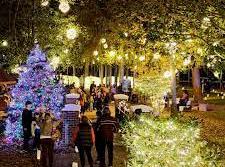
Bundle up and enjoy a winter stroll around this historic park. The mineral spring and gazebo look especially picturesque in the crisp winter air, and it’s a peaceful spot to enjoy some hot cocoa and relax.

Warm up with a seasonal craft beer at Aviator, known for its rich porters and stouts perfect for winter. The cozy indoor spaces of their Smokehouse and Taphouse add to the winter vibe, with hearty BBQ and warm drinks to boot.

Both downtown districts come alive with holiday decor and lights. Browse through boutique shops and pick up unique gifts, cozy winter apparel, and locally crafted goods.

The town’s annual tree lighting ceremony is a heartwarming way to start the season. Gather with the community to sing carols, sip hot drinks, and watch the tree light up downtown.
Kick off the season with this annual parade. Local floats, marching bands, and Santa himself make this a beloved winter tradition for the whole family.


Meet renowned artist Alfred Gockel at Ashley Art Gallery! Explore his bold, vibrant artworks, learn about his creative journey, and gain insight into his signature style. An inspiring event for art enthusiasts!

For those who enjoy nature in the winter, this park offers brisk hiking trails where you can appreciate the quiet beauty of the season. Watch for wildlife that’s easier to spot without the dense summer foliage.



The Arts Center hosts winter-themed performances, concerts, and art exhibits. It’s a fantastic indoor activity to enjoy cozy, family-friendly entertainment out of the chill.
Santa is coming to Piney Town! Families can enjoy a magical visit with Santa, perfect for photo opportunities, sharing wish lists, and festive fun in a holiday-themed setting. The event promises a warm, memorable experience for all ages, making it a wonderful seasonal outing.
A variety of outdoor experiences, from scenic nature trails to guided hunting opportunities. Perfect for outdoor enthusiasts, the location provides a unique mix of rifle, shotgun, and air gun ranges set within a beautiful wooded area.
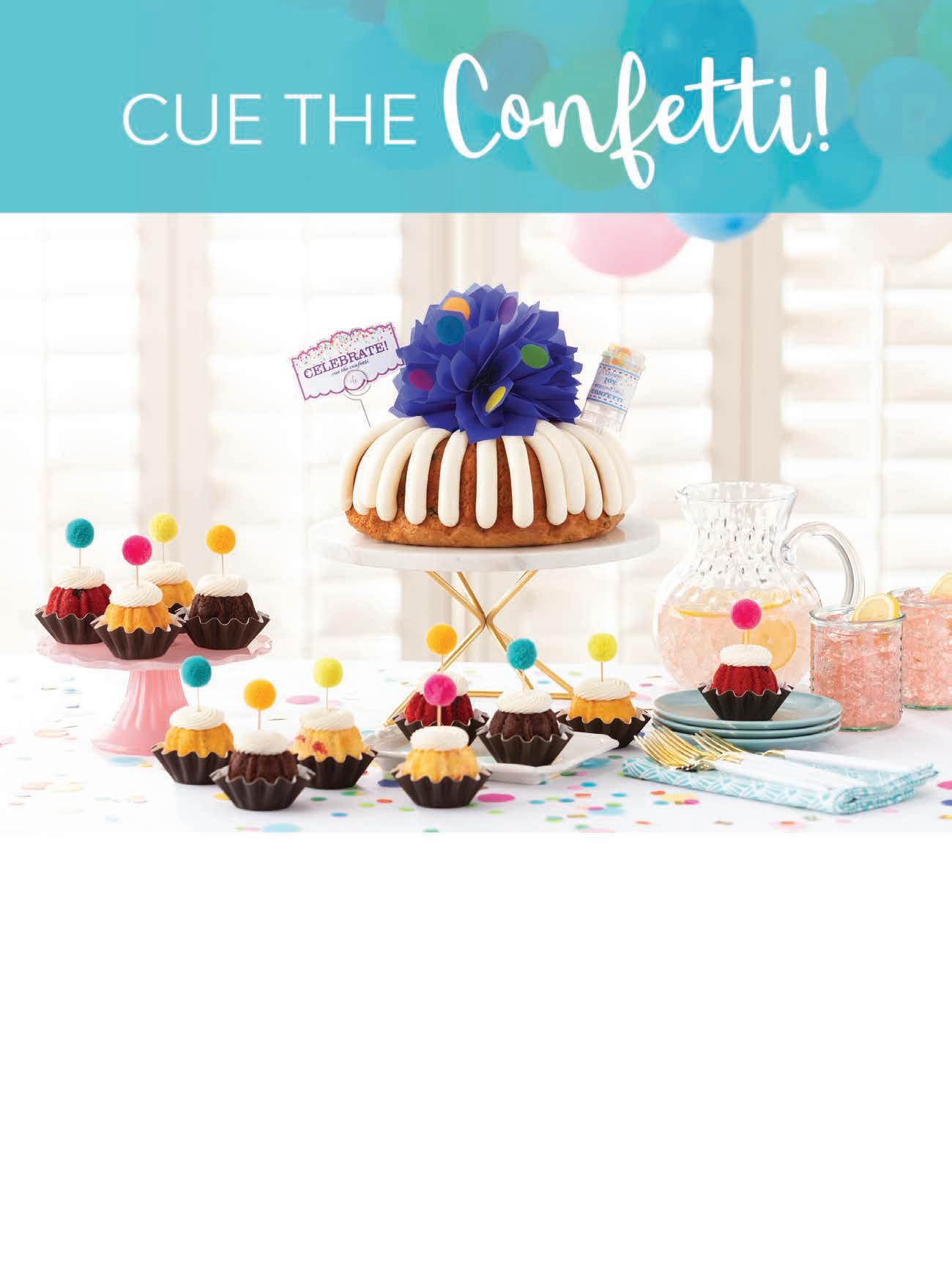

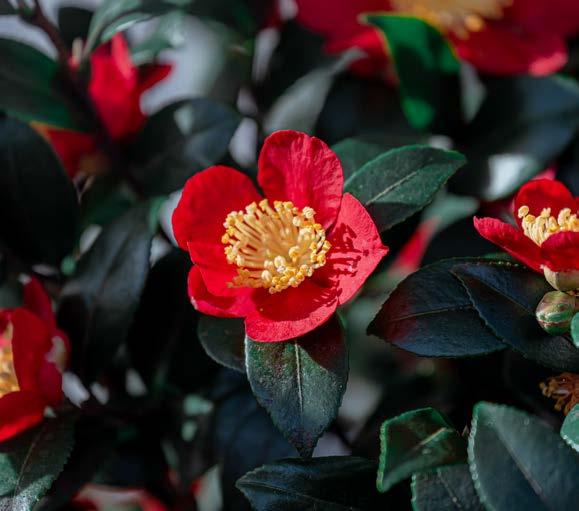
3012
PUBLISHER
Curtis Media Group
GENERAL MANAGER
Carolyn Carver
ccarver@curtismedia.com
EDITOR
Chip Winstead
ADVERTISING SALES
Chris Hooks
Mike Sleyman
Chip Winstead
Sophie Gray
Jon Sheldon
CONTRIBUTING WRITERS
Mike Raley
Chris Hooks
Lariss Runkle
Greg de Deugd
Sarah Christas



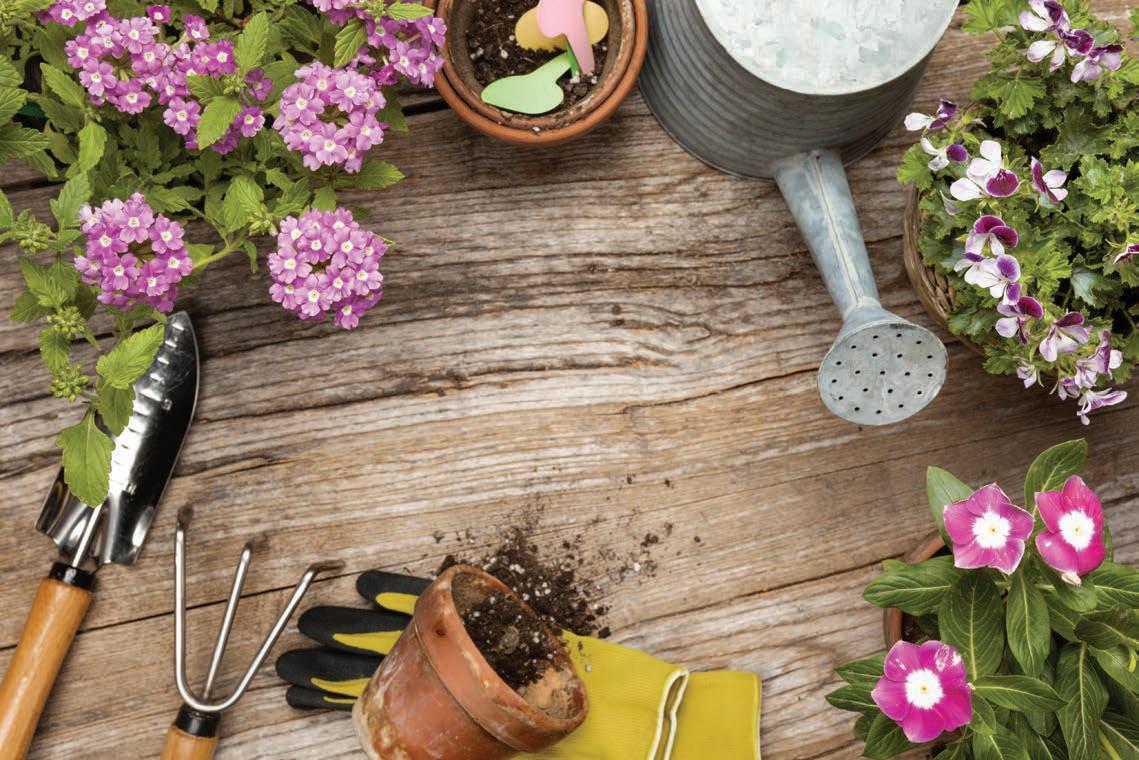


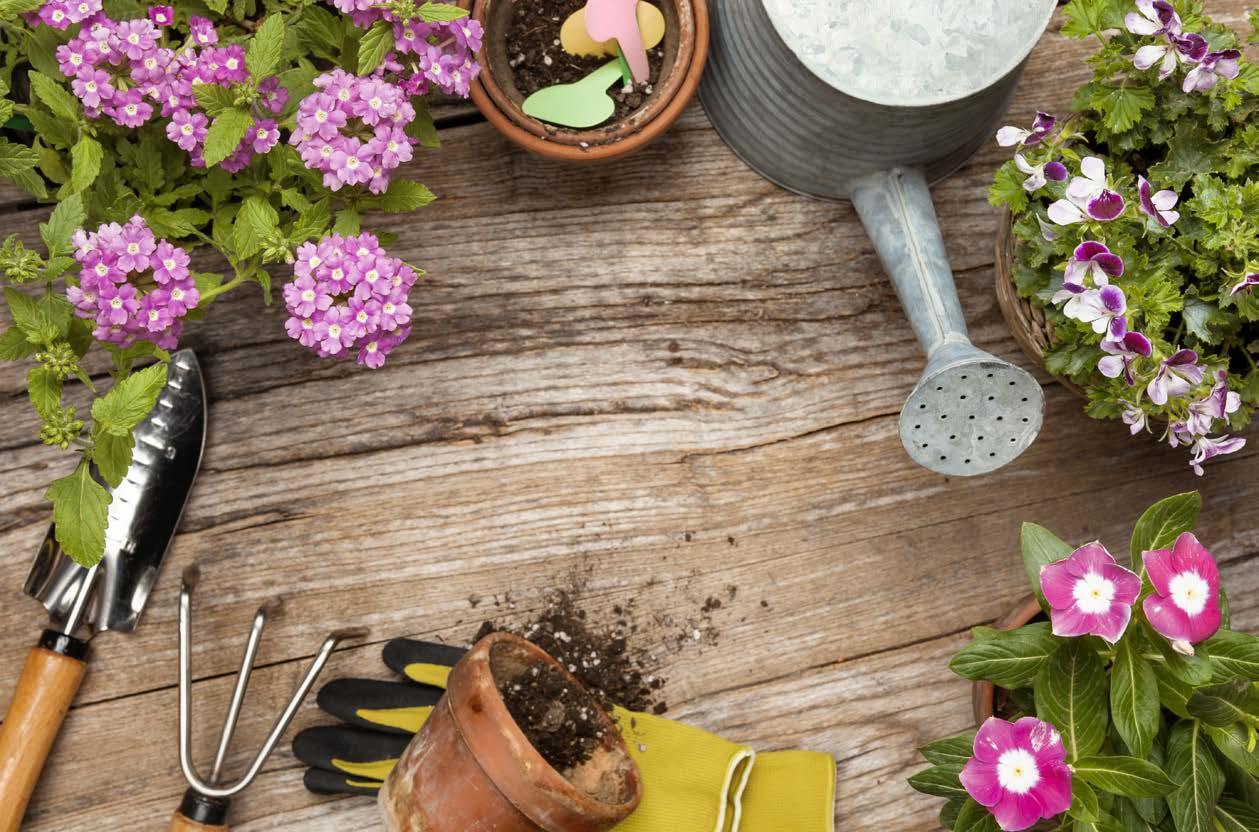



BY MIKE RALEY
How does one find the words to put into perspective 40 years of hosting almost two thousand WPTF Weekend Gardener episodes? Indeed, 2025 is a milestone year for me: the 40th anniversary of my gardening show, my 50th year as a WPTF announcer, newsman, and talk show host, and my 50th wedding anniversary. Yes, my wife, Melissa, has graciously put up with me and this crazy business for five decades.
It all started in the winter of 1985. The late NC State horticulture professor emeritus, John H. Harris, informed WPTF management that he would retire after 40 years as host of the award-winning Tar Heel Gardener program. Though John’s show ran just 15 minutes every Saturday, he was an icon, and his departure was a significant loss for WPTF. Management
decided to continue the program, extend it to 30 minutes, and transform it into a call-in talk show. They also brought in new hosts. As the early Saturday morning disc jockey, I had the pleasure of working with John on his last few shows and was honored to help carry the program forward. Thankfully, John was clear that I wasn’t the reason he decided to leave! Wake County extension service horticulture specialist Erv Evans joined me as co-host.
Had you told me 40 years ago that I’d spend a good part of my life hosting a garden show, I would have laughed hysterically. I was busy hosting another classic WPTF talk show, Ask Your Neighbor, following in the footsteps of legendary broadcasters Charlie Gaddy, Bart Ritner, and Maury O’Dell. Gardening wasn’t exactly on my list of priorities at 33, so I expected a rough
start. Our first task was renaming the long-running show to honor John. Thus, The Weekend Gardener was born.
Unfortunately, Erv developed a condition that greatly affected his voice and had to step down. Thankfully, Wake County master gardener Anne Clapp, who had subbed for Erv a few times, agreed to join me. Anne was extraordinary—retired as a textile professor from NC State University, she knew as much about gardening as any horticulture graduate. She co-hosted with me from 1992 until her retirement in 2022. What a remarkable run! Together, we kept The Weekend Gardener one of the most popular shows in WPTF history.
In 2006, the show got an incredible boost. I learned that former North Carolina Attorney General, Secretary of State, gubernatorial candidate, and Senate “Watergate” committee Chief Deputy Counsel Rufus Edmisten was a gardener. He joined us as an occasional panelist, a role that evolved into co-host. Rufus brings gardening expertise, mountain wisdom, funny anecdotes, and life experiences. He is one of my closest friends and a cherished part of our show.
Since our first episode in January 1985, The Weekend Gardener has thrived. We’ve won awards, but none meant as much to me as appearing on William Friday’s UNC-TV program North Carolina People in March 2006. Dr. Friday, a longtime Weekend Gardener fan, even worked as a spotter for WPTF football broadcasts in the 1940s. His occasional calls to the newsroom or to the show to talk about his prized peonies were an honor.
In 2024, Governor Pat McCrory declared January 24 as WPTF Weekend Gardener Day in North Carolina in honor of our 30th year. Over the years, our time slot expanded from one hour to two, and by the early 1990s, to three hours. High ratings and ad revenue have certainly contributed to our longevity, but I think our personal connection with our audience is the real key. Many listeners have followed the show from the beginning, sharing in our memories and calling from all over North Carolina—even from vacations or after moving far away— to hear a bit of “home.”

In addition to Rufus, I’ve been blessed with expert gardeners: Pam Beck, Tony Avent, Nelsa Cox, Phil Campbell, Josh Logan, Gerald Adams, Roy Lewis, Mark Weathington, Craig Lahoullier, Helen Yoest, Andrea Laine, Jim Wilson, P. Allen Smith, Chuck Friedriedrick, extension agents like Erv Evans, Paul McKenzie, Johnny Coley, Mart Bumgarner, Amanda Wilkins Bratcher, Colby Griffin, Marshall Warren, Toby Bost, Sean Gurkin, Lewis Howe, Jeana Meyers, and many more. What an extraordinary group! I’ve learned something valuable from each of them. Our listeners are also a priceless resource, and our sponsors, along with strong ratings, have kept us on the air. I could never adequately thank either group.
The greatest honor has been connecting with our family of listeners, who rely on The WPTF Weekend Gardener for advice in caring for their landscapes in a friendly, conversational style—like gathering around the “pickle barrel,” as I did in my youth at my Aunt Oralee’s country store near Louisburg. Everyone needs a way to relax, and this show has not only provided me with a livelihood but also with a hobby that has carried me happily into my golden years.
Rufus, our group of gardeners, and I may not be part of The Weekend Gardener 40 years from now, but the memories we’ve made will endure. Many thanks to my former bosses at Durham Life Broadcasting, my longtime boss Don Curtis, and my beloved family, who gave up many Saturday mornings for my work. Above all, my heartfelt thanks to our listeners—for making these 40 years the best of my life.

1363 W. Market Street
Smithfield NC, 27577
919-934-6066


CSS also offers a caregiver support group for caregivers of those with Alzheimer’s, Dementia, or Parkinsons.
Call Haley Sutton at 919-934-6066 for additional information on these and other events.
Community and Senior Services of Johnston County (CSS) boasts 3 Centers of Excellence as well as a satellite center for Active Aging
Benson Center for Active Aging
1204 N. Johnson Street, Benson NC, 27504 (919) 701-1477 I Hours: 8:00 - 4:30 M-F
Facebook/BensonCenterforActiveAging
Clayton Center for Active Aging
303 Dairy Road, Clayton NC, 27520 (919) 553-4350 I Hours: 8:00 - 4:30 M-F
Facebook/BensonCenterforActiveAging
Harrison Center for Active Aging 611 West Noble Street, Selma NC, 27576 (919) 965-2627 I Hours: 8:00 - 4:30 M-F
Facebook/HarrisonCenterforActiveAging
Smithfield Senior Center (Satellite Site) 606 Caswell Street, Smithfield, NC 27577 (919)934-8701 I Hours: 8:00 - 1:30 M-F
These Centers offer a wide variety of classes and activities that reflect the participants’ skills, interests, and diverse needs. These centers are FREE to anyone 50+ and offer congregate lunch to anyone 60 and older! CSS manages a Senior Dining Center as well.
Princeton Dining Center 412 W. Third Street, Princeton NC, 27569 (919)936-2184 I Hours: 9:00 - 1:00 M-F
Visit our website for more information. There, you will also be able to view the monthly calendar of activities and events at each location!
www.cssjohnston.org

CSS offers Home Delivered Meals to seniors delivered with the help of Volunteers. If you would like to volunteer with delivering meals or would like to hear about other volunteer opportunities please contact Crystal Fornwalt at 919-934-6066.
CSS also offers an In-Home Aide program, a Transportation program and other various programs throughout the year for seniors in Johnston County. Please call our office or visit our website for more information.


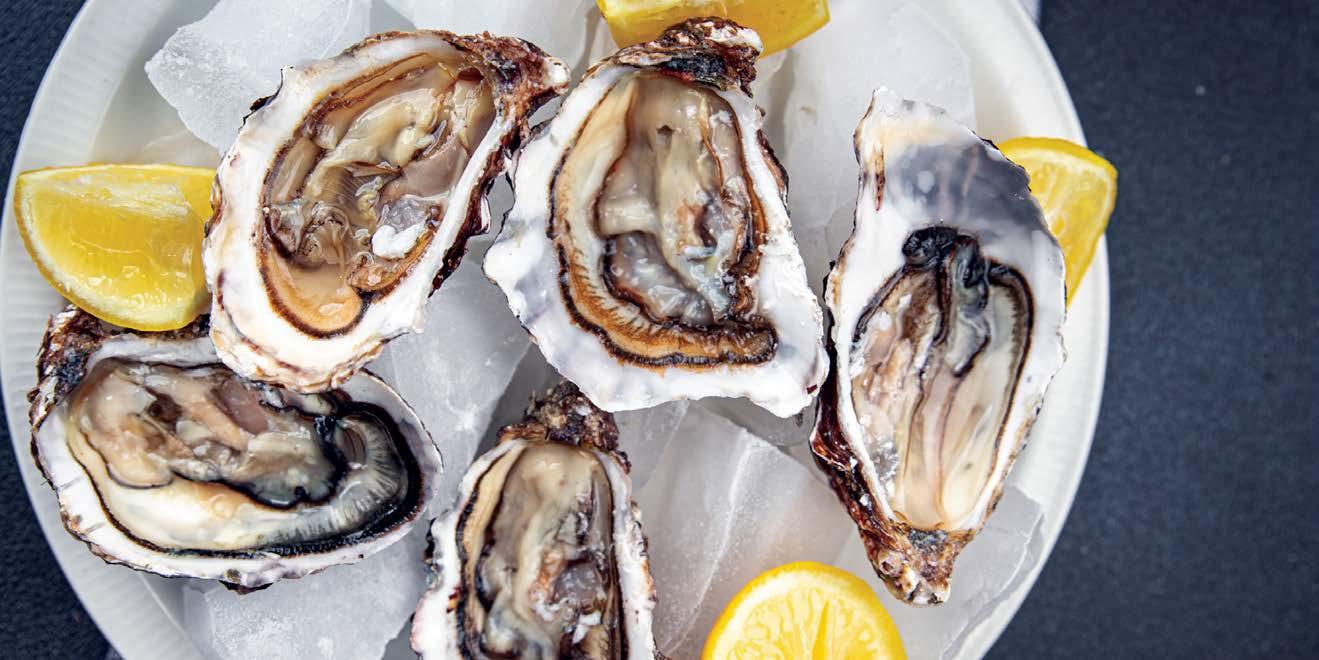




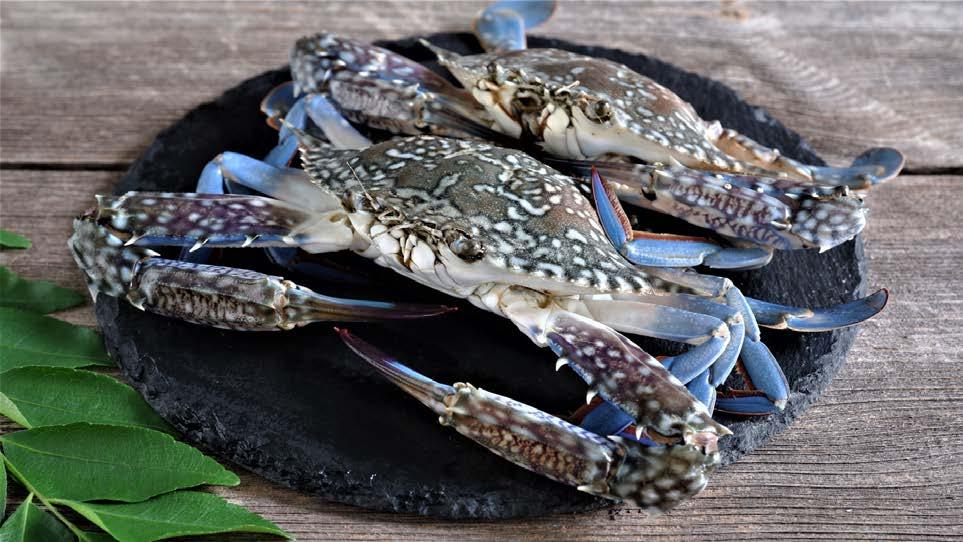
BY MIKE RALEY
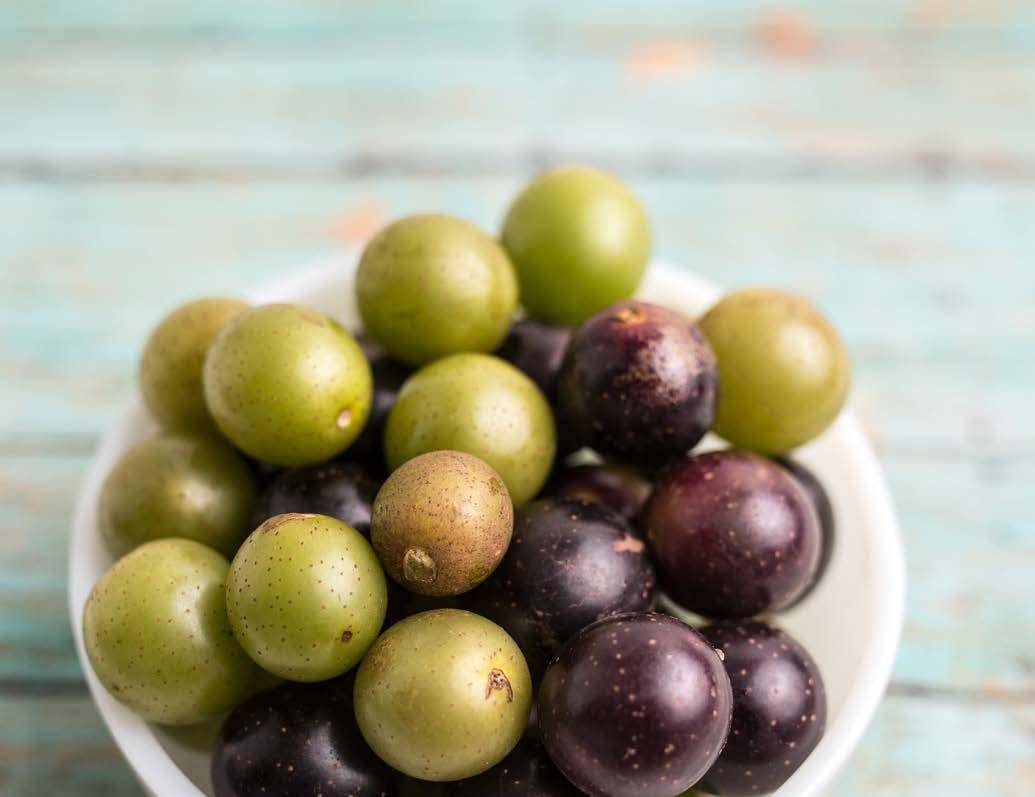
Ilove Manteo and the surrounding area for many reasons. Part of the Outer Banks of North Carolina, Manteo is nestled on picturesque Roanoke Island, home to The Lost Colony, where Andy Griffith spent many of his happiest days. Historians also note that this is where Sir Walter Raleigh discovered muscadine grapes growing in the “Scuppernong” region of the Tar Heel State. In fact, the oldest known grapevine, over 400 years old, is located on Roanoke Island! It’s believed that these grapes were likely cultivated by the Croatan Indians. The first recognized muscadine variety was developed in the 1760s in what is now Tyrrell County, possibly along the Scuppernong River. These grapes were an excellent food source, and the Spanish explorers and others used the bronze or white grapes to make plenty of wine.
One of my fondest memories growing up in Nash County was eating scuppernong grapes straight from the vine, whether in Nashville or on a relative’s farm in Franklin County. Sometimes I had permission; other times, I just sneaked a few! Luckily, they were a healthy and delicious summer treat for a child of the 1950s and ‘60s. Adults enjoyed them too, often using them for jellies or making a batch of homemade wine.
Muscadine grape varieties—bronze, red, and black—are native to North Carolina and adapt well to our soil and weather conditions. A soil pH of 6.5 is ideal for muscadines, and I’ve even heard that old tobacco fields work well for muscadine vineyards. They are quite resistant to insect pests and diseases, making them relatively easy to grow. Grapes thrive in plenty of sun and
good drainage; after all, have you ever seen a soggy, shady vineyard?
For those interested in planting muscadine grape vines, wait until after the last frost in the spring. Most home vines I’ve seen, including the one on my wife Melissa’s parents’ farm, are long trellises with poles to support the vine’s weight. In my hometown of Nashville, grape arbors or pergolas were also common. They add an attractive touch but require proper construction, like the impressive structure in the Biltmore gardens.
To build a trellis, typically, three or four double #9 wires are strung between treated wood supports. Plant vines at the same depth as the root ball container, spacing them 8 to 10 feet apart. When setting up a trellis or arbor, you must train the grape seedlings. The NC Cooperative Extension Service recommends cutting back to 2 or 3 buds. Once new growth appears, select the strongest shoots, cut away the rest, and stake them.
Loosely tie the shoots to the stake, adjusting them as they grow, and remove the side shoots. When the shoot reaches the wire or arbor top, cut the growing tips to encourage lateral growth, which will allow the vine to spread across the wire. Over the next year, let the side shoots develop—they’ll produce the flowers and fruit.
Fertilize your plants in late March and then every six weeks until July. Although the Extension Service has specific formulas for fertilizer, a 10-10-10 blend often works well. Keep the area around your plants free of weeds. Enjoy the process, share the memories, and only make wine if you’re serious!
In the tradition of WPTF’s Ask Your Neighbor, I’ve included a recipe for grape jelly below, courtesy of my late mother-in-law, Jean Reeves. Once SURE-JELL was available, she used the recipe from the box with a few personal modifications. Enjoy!
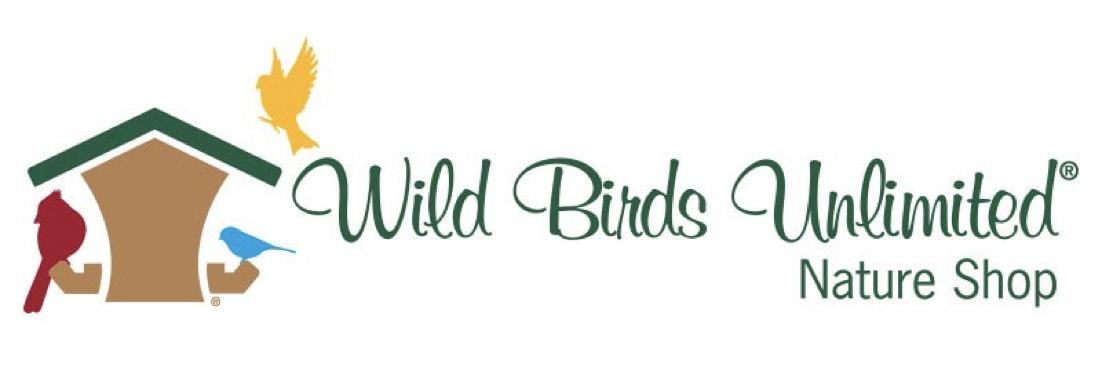
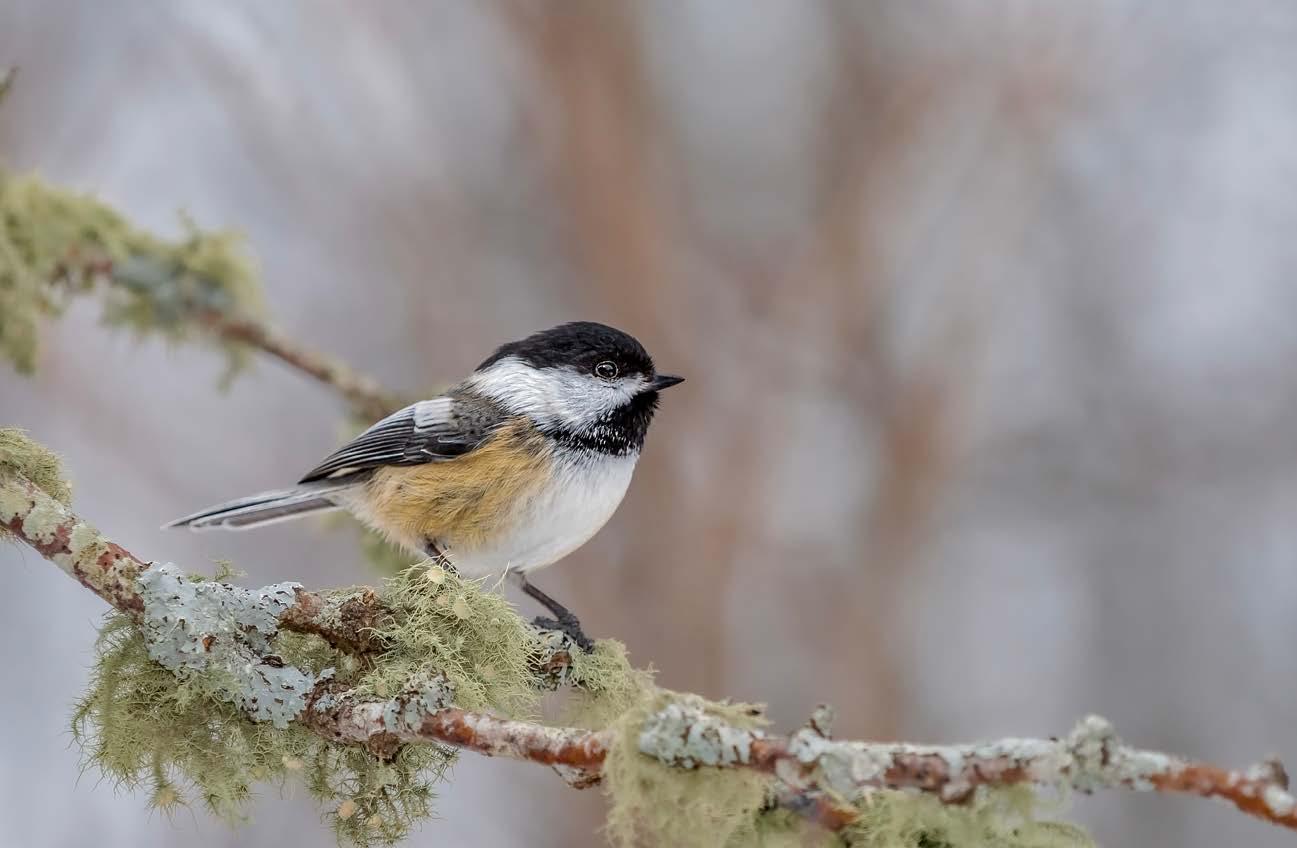
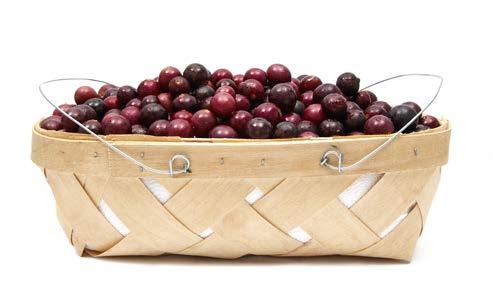
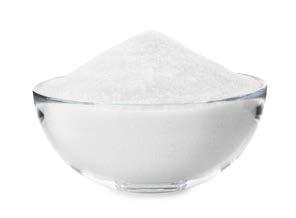

1. Wash Grapes & Remove Stems
Begin by washing the grapes and removing stems. Although SURE-JELL suggests crushing the fruit first, I prefer to let the fruit “bust” naturally during cooking. If needed, you can lightly crush them afterward.
2. Cook the Grapes
Place the grapes in a large saucepan and add about 1 to 1½ cups of water. Bring the mixture to a boil, then simmer for at least 10 minutes or until the grapes burst.
3. Strain the Juice
Pour the cooked grapes into a country ham sack, tie the sack on a strong stick positioned between two chairs, and let the juice drain into a pan. Avoid squeezing the bag to keep the jelly clear. Once strained, the juice can be used immediately for jelly or refrigerated/frozen for later.
NOTE: Store-bought juice without added sugar can substitute for fresh juice.
• 5 cups prepared juice (about 3½ lb. of fresh grapes)
• 7 cups of sugar
• 1 box of SURE-JELL
• ½ tsp butter or margarine (optional, to reduce foaming)
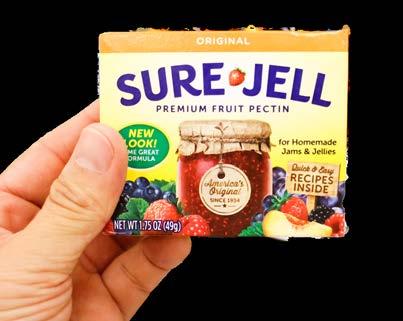
Measure the exact amount of sugar into a separate bowl. Then, measure the grape juice and pour it into a tall stockpot (juice and jelly will expand during cooking).
2.
Slowly stir in SURE-JELL, then add the butter or margarine if desired.
3. Boil the Mixture
Bring the mixture to a full rolling boil over high heat, stirring constantly. Once it reaches a boil that cannot be stirred down, add the sugar. Continue stirring and bring to a rolling boil again, then
While cooking the jelly, sterilize lids and jars by simmering them in boiling water for 10 minutes. Place a kitchen towel in a large roasting pan, add several inches of water, and set the jars upside down in the pan. Flat lids can simmer separately in a small saucepan. Ensure jars and lids are hot when filling with the jelly mixture.
boil exactly 1 minute. Remove from heat.
Ladle the hot jelly into hot jars, leaving ¼ inch of space at the top. Wipe any drips off the jar tops and sides, place a hot flat lid on each jar, and screw on the ring tightly. Invert jars on a rack for 5 minutes. Then, turn jars upright and allow them to cool. You should hear a “pop” as the jars seal.
5. Store
Store jars in a cool, dry place and enjoy your homemade jelly!





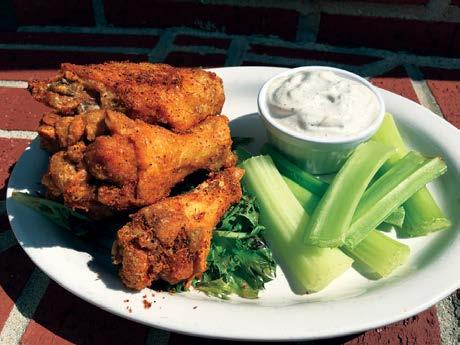

Your neighborhood restaurant and bar since 1999! Enjoy a hot meal or grab a cold drink. 21 rotating beer taps, custom cocktails, pool tables, and dart boards,
Mon - Free Pool 6-8pm Tue - Trivia 7-9pm Wed - 1/2 Price College Meals Thurs - Prime Rib 4-10pm Fri - Live Music
HOURS
M-F 11am - 2am SAT/SUN 10am - 2am
Last Call 1:45am
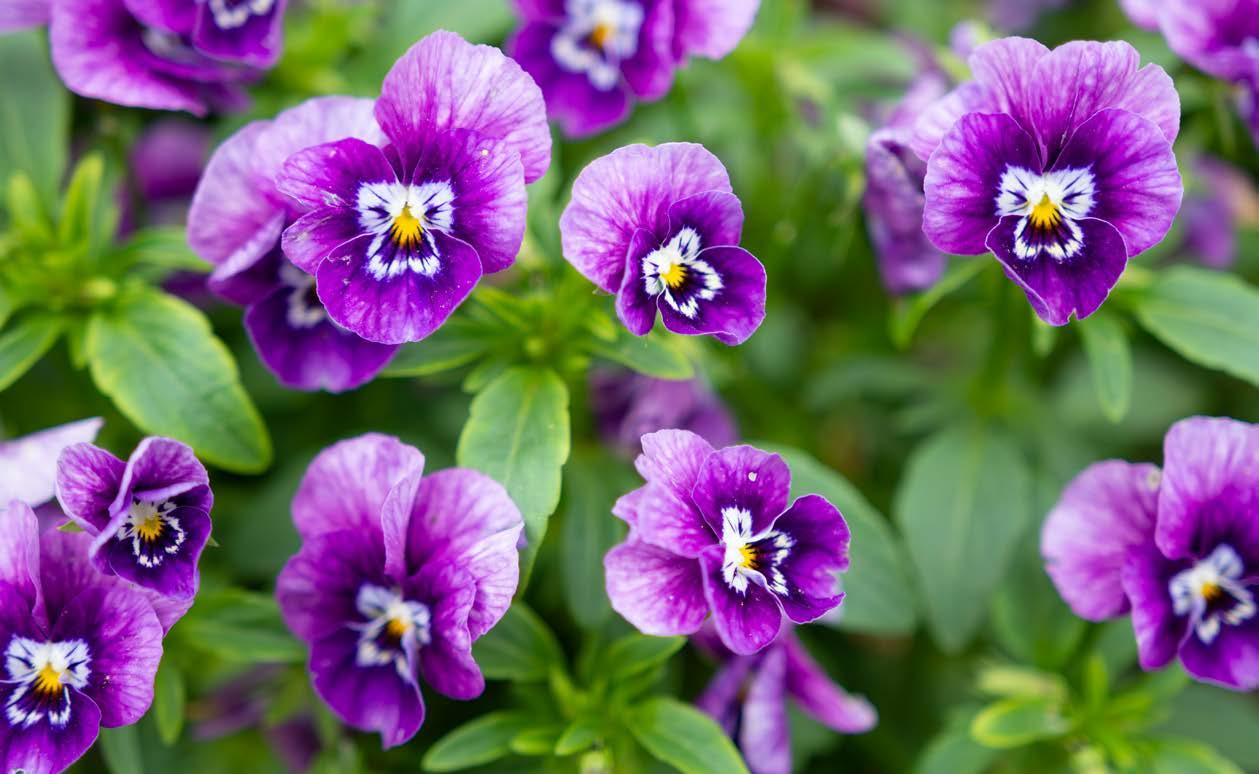
BY MIKE RALEY
Ican vividly remember visiting Sunset Nursery in Rocky Mount with my mother, from my pre-teen years well into my 40s. She was not an avid gardener, but she so enjoyed her camellias, azaleas, and annuals. Pansies were her favorite, and we made a yearly pilgrimage on a fall day to “Sunset” for a couple of flats of the colorful, velvety, “big-faced” flowers. When I was older, I married the best girl in the world, and during our wedding, she carried a bouquet of pansies. They are among her favorites too.
Pansies prefer cool weather, and in the old days, they were planted in September. You can still find plenty of pansies for sale then, but these days, they are happier if you wait to plant in October or November here in central and eastern North Carolina. Otherwise, they are more prone
to disease and insect problems. They definitely don’t like our hot weather. Remember how they look in May and June as the temperatures heat up? They start to wither.
I’ve always thought pansies can be a bit hard to care for sometimes. To get the best out of these beauties, plant them in full sun and in an area that has good drainage. If you see a bed of pansies planted in a commercial development by a professional, they are often planted en masse in raised beds for excellent drainage. Many people prefer planting pansies in containers, which works well. Just find a good-quality soil mix that drains properly, and don’t forget to choose a container with drainage holes. I would recommend grouping them together in the container for a fuller look— have fun mixing colors too, as there are so many
to choose from.
They do need water during fall and winter warm spells, but be cautious. Water in the morning instead of the afternoon, especially if there’s been less than an inch of rain during the week. If the top inch of soil is dry, it’s time to water. However, overwatering can lead to fungal diseases and root rot—so don’t go overboard!
If you are serious about your plants, you should occasionally get a soil test. Soil in the Triangle area is generally fairly acidic. According to my friends at NC State, pansies prefer a pH between 5.4 and 5.8. Anne Clapp and Phil Campbell recommend mixing a bit of blood meal into the soil when planting pansies. Some say it repels rabbits but attracts dogs, which I can confirm! In general, a low-nitrogen, slow-release fertilizer works well. Some experts suggest a water-soluble fertilizer, but don’t apply it when the plants and soil are wet. It’s also helpful to mix in good organic matter like Black Kow or Daddy Pete’s.
Phil Campbell says you can’t just leave spent blooms on pansies. Keeping an attractive pansy bed requires a little work. Take a small pair of scissors or your fingers, and clip or pinch off the spent blooms at the bottom of the stem to discard them. This helps protect new flowers from disease and insects and encourages more blooms.
Regarding pests and diseases, you may encounter an occasional slug, snail, spider mite, mildew, or leaf spot. Keep an eye on your plants for these issues.
There are numerous varieties of pansies available in North Carolina, from the “big face” varieties to the self-seeding violas or “Johnny Jump-Ups.”
Remember, if you care for your pansies properly (and take Phil Campbell’s advice), they will provide months of striking fall, winter, and early spring color in your landscape or containers.
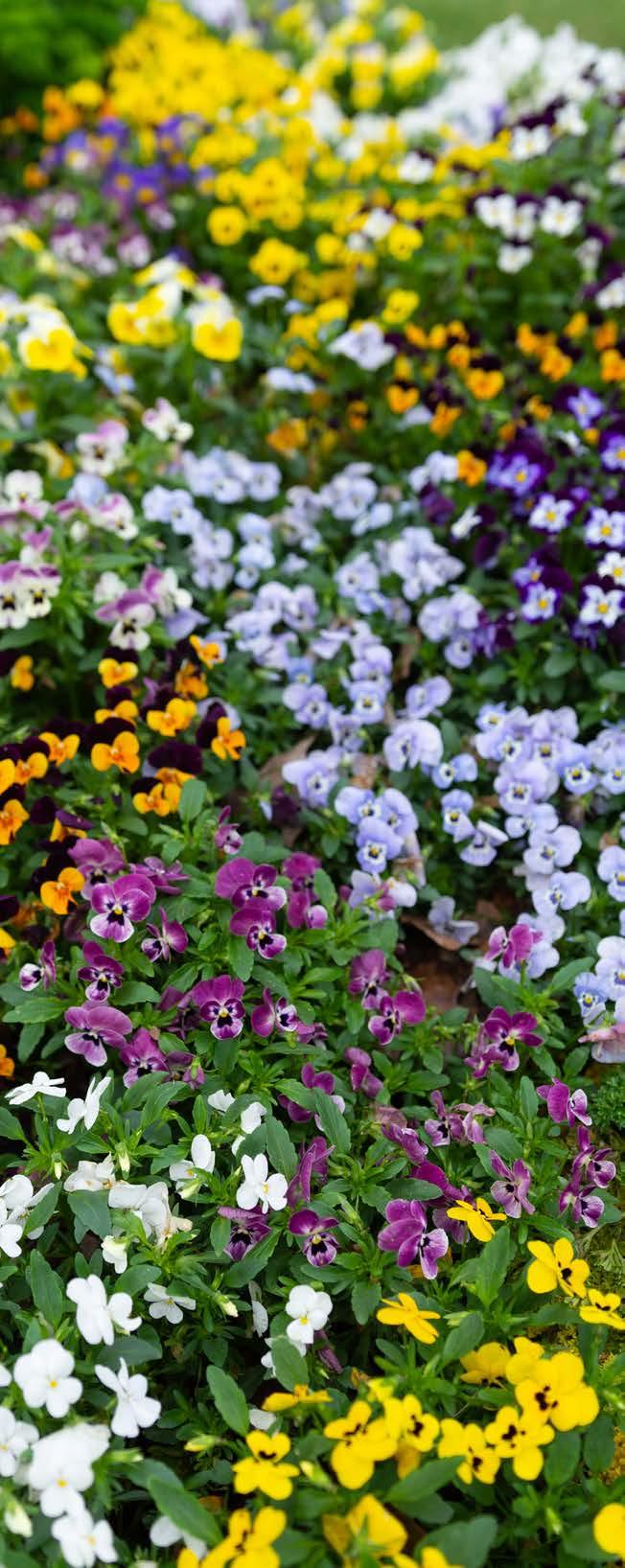
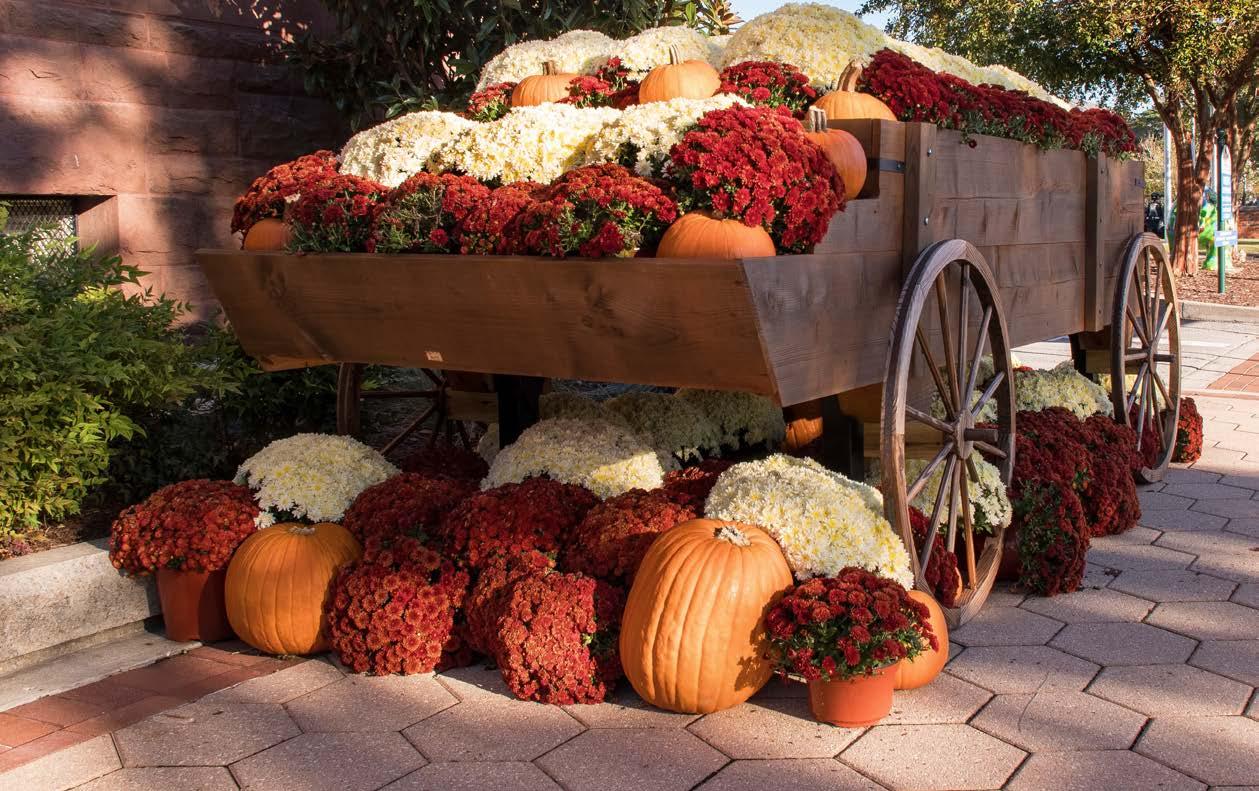
BY MIKE RALEY
Iam very fond of fall and winter. I always have been. Among the delights of that time of year are the many colors—from pumpkins to corn stalks, to apples, to mums. You have probably heard the saying many times that “chrysanthemums remind one of fall and they are so striking, but they fade and then they’re gone.” This is so often the tragic life of the mum. I am partial to those bright yellow mums where the color really jumps out at you. The maroons, purples, and oranges are nice too.
If you are a fan of the flower show area at the NC State Fair, and I am, then you are aware of
the “mum tower” that is popular with attendees. This year there was a huge display of mums of various colors placed strategically to form a very prominent likeness of a North Carolina flag. It is a spectacular way to display flowers. Just like pansies or most any other annual or perennial flower, plant in mass.
Mums are treated as seasonal annual flowers, but they are actually perennials. Some experts do point out that mums are not usually raised to survive cold weather and may not bloom well the next year. But, you can actually plant them and spur blooming for several years with a little care.

First things first: go ahead and get them in the ground before the first frost, which is usually in early November. Chrysanthemums like full sun and well-drained soil. They prefer to be planted at the same depth as they are in their container.
Some of the experts advocate that you break up, loosen, or spread out the roots. Do this if you plan to keep and plant your mums. Go ahead, switch the mums to a new, bigger container or place them in the ground. Ok, you know the drill: add some good organic matter and mix with your native soil. You may incorporate Black Kow, Daddy Pete’s, or maybe you have seasoned a little compost of your own. Cover the root ball and tamp down the soil to stabilize the newly planted mum.
Everything needs water. Your chrysanthemums need water, but like most plants, they don’t like wet feet. Meet their water needs diligently until they are established. What do we mean by well-established? The plant should have a strong root system—give it a tug. Plus, it should have some new growth. That’s well established.
I always say everyone seems to enjoy feeding their plants. Sometimes we overfeed our plants just like we overdo it with our own eating habits. Add some slow-release fertilizer when you plant
your mums in a container or the ground. If you are serious about this project, you should fertilize your mums with a water-soluble or liquid fertilizer during the spring and summer.
One of the most important tricks for maintaining a chrysanthemum is “pinching” back the flower heads down to the first leaf. You should do this in the fall when the flowers start fading and turning brown. You need to continue that process during the spring and summer. Mums will form flower buds during these seasons and try to bloom, but if you are diligent, you can prevent the plant from blooming until fall comes around again.
Mums will go dormant when it finally gets cold. That’s when you should check the mulch. Three to four inches of hardwood mulch or pine straw will help keep the roots from freezing should you choose to plant the mum in the ground.
As I stated in the beginning, I love mums in the fall. Try a season of mums and see how it works out. If that’s not your thing, buy mums in September, care for them for two or three months, and then ditch them or add them to the compost pile. Why not some fall mums to get in the spirit of the season and to support the nursery industry?

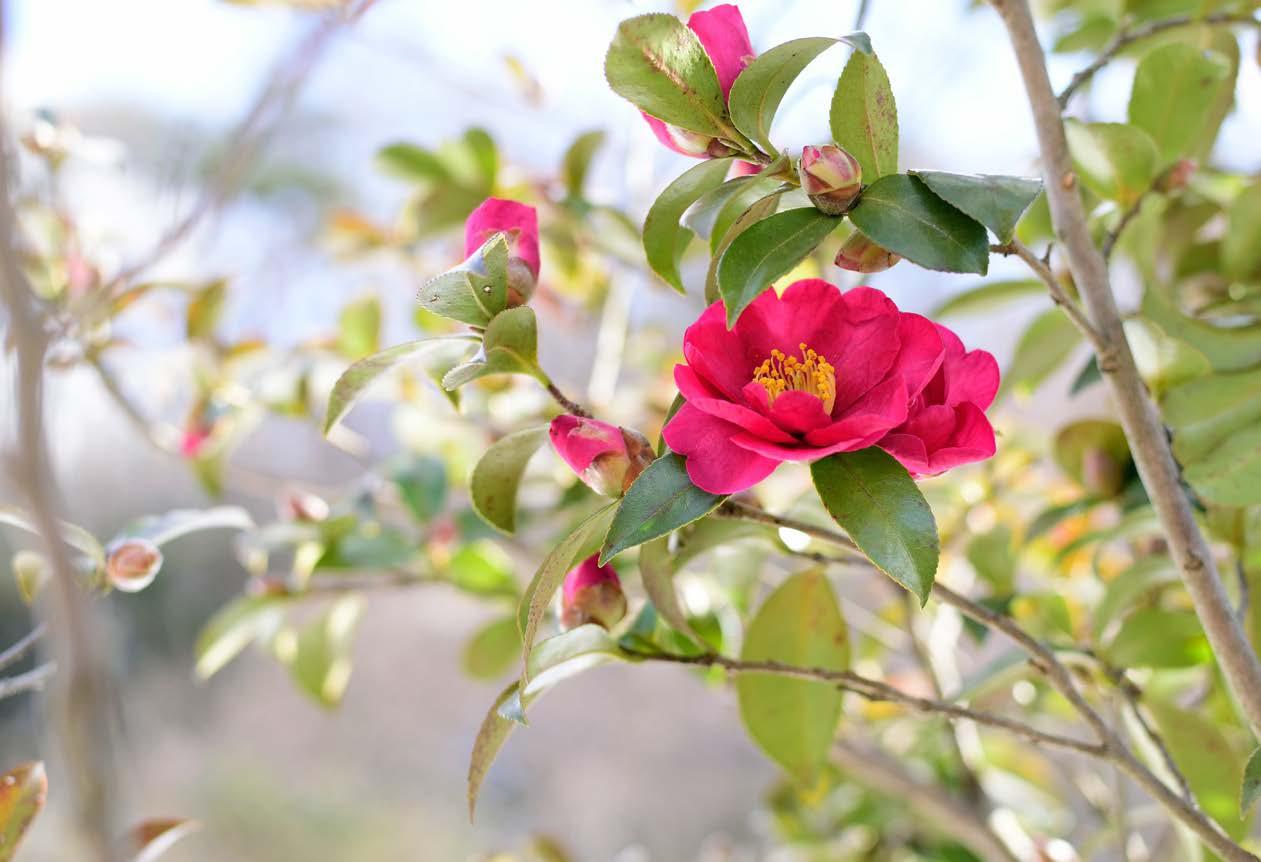
BY MIKE RALEY
Ioften equate some of my gardening experience with my mom. While this is true, just like my education in broadcasting, I have been highly privileged to work with some of the best gardening professionals in the state. For instance, Anne Clapp taught me a great deal about the joys of growing sasanqua camellias. She has over a hundred on her property, as does Rufus. Anne loved the japonica and sinensis varieties too, but there is something about the dark green leaves acting as a background for some of the loveliest flowers on any shrub this side of roses. No one on our panel has ever said a negative word about sasanqua camellias! They are one of my favorite plants for the
North Carolina home landscape.
Sasanqua camellias are relatively easy to grow and could give you decades of pleasure. In fact, I’m told they can live up to 200 years, though perhaps not in the Tar Heel state. There are numerous handsome examples all over the state at historic sites, arboretums, and private homes.
Fall is a great time to plant sasanqua camellias, as that’s when they grace us with their perfect blooms. They seem to bloom earlier each year due to our warmer climate. From red to pink, white to purple, or combinations and shades of all four, this native plant of Asia will fill your landscape
CONTINUED PAGE 28
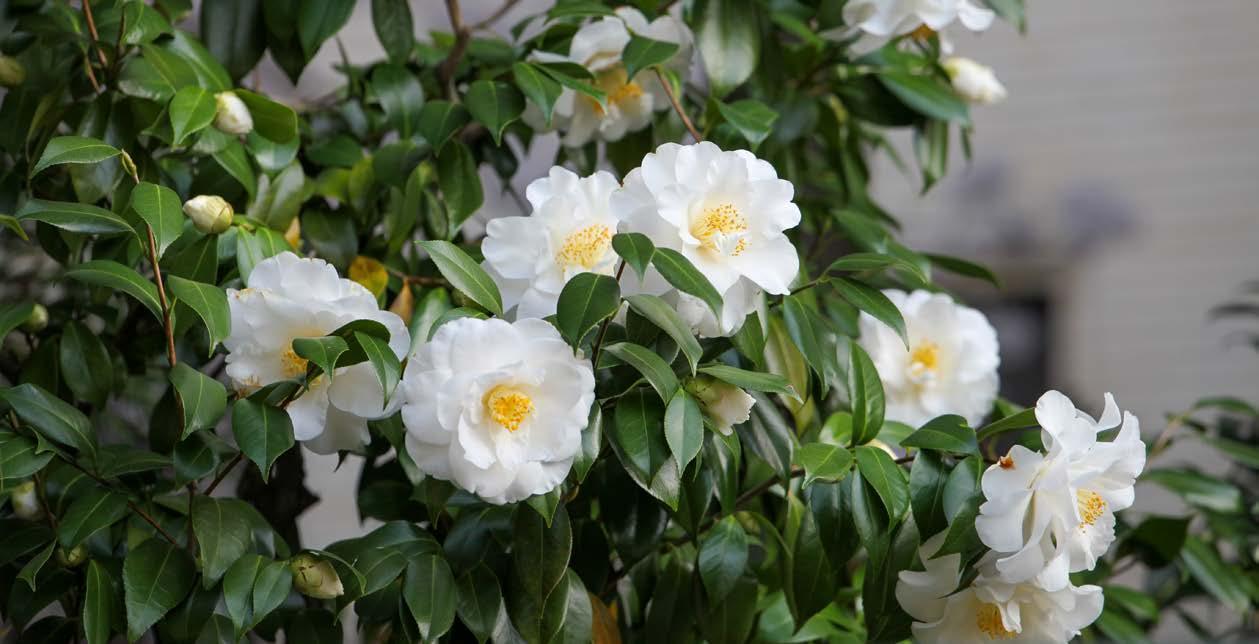
with plenty of color.
Growing naturally in the forests of Japan, China, and other countries, they have adapted well to North Carolina. And you won’t run out of varieties either—there are over 200 species of sasanqua camellia in the world. Like many other woody ornamentals, there are dwarf varieties available too.
Sasanqua camellias need a little help if they’re going to thrive. Placement in the landscape is important. A partially shady spot with some morning sun should work well. Full sun in most parts of North Carolina won’t serve these plants well. They don’t seem to mind our clay or sandy soils as long as they are well-drained. Experts recommend adding some good organic matter or compost. If you’re serious about optimal growth, consider a soil test before planting; a pH of 6.0 is ideal, within the acidic range.
Give sasanqua camellias some room to grow. They may reach 7 to 15 feet tall and 5 to 7 feet wide, while japonicas can grow even larger. They grow fairly quickly, but not like Leyland Cypress. When combined with other plants, they create a beautiful hedge. My mother even trimmed one into a tree form, and I’ve seen others do the same for a more formal look. Some people use them
on trellises or espaliered, but that does add extra maintenance.
My favorite variety is Yuletide, with its bright red flowers—sort of a “Wolfpack” red! Rufus prefers a pink and white cultivar named Our Linda. Miss Anne has too many favorites to count! Pick out your favorite, and before you know it, you’ll have a yard full of sasanqua camellias.
Anne always recommended using cottonseed meal for any type of camellia, but a good quality, low-nitrogen, balanced fertilizer applied in early spring should keep your plant happy.
Pruning is easy if you follow two important rules: prune sparingly, allowing your plant to grow to its normal size, which will keep it healthy and colorful in the fall. Secondly, prune your sasanqua just after it blooms to ensure a full flower display the following year.
Sasanqua camellias may occasionally suffer from diseases and insect issues. Scale is probably the worst insect problem, but you may also encounter aphids or spider mites. In terms of diseases, funguses, mold, canker, petal blight, and root rot are among the potential issues. However, proper planting, good placement, and best practices will go a long way in keeping your sasanqua camellias healthy.


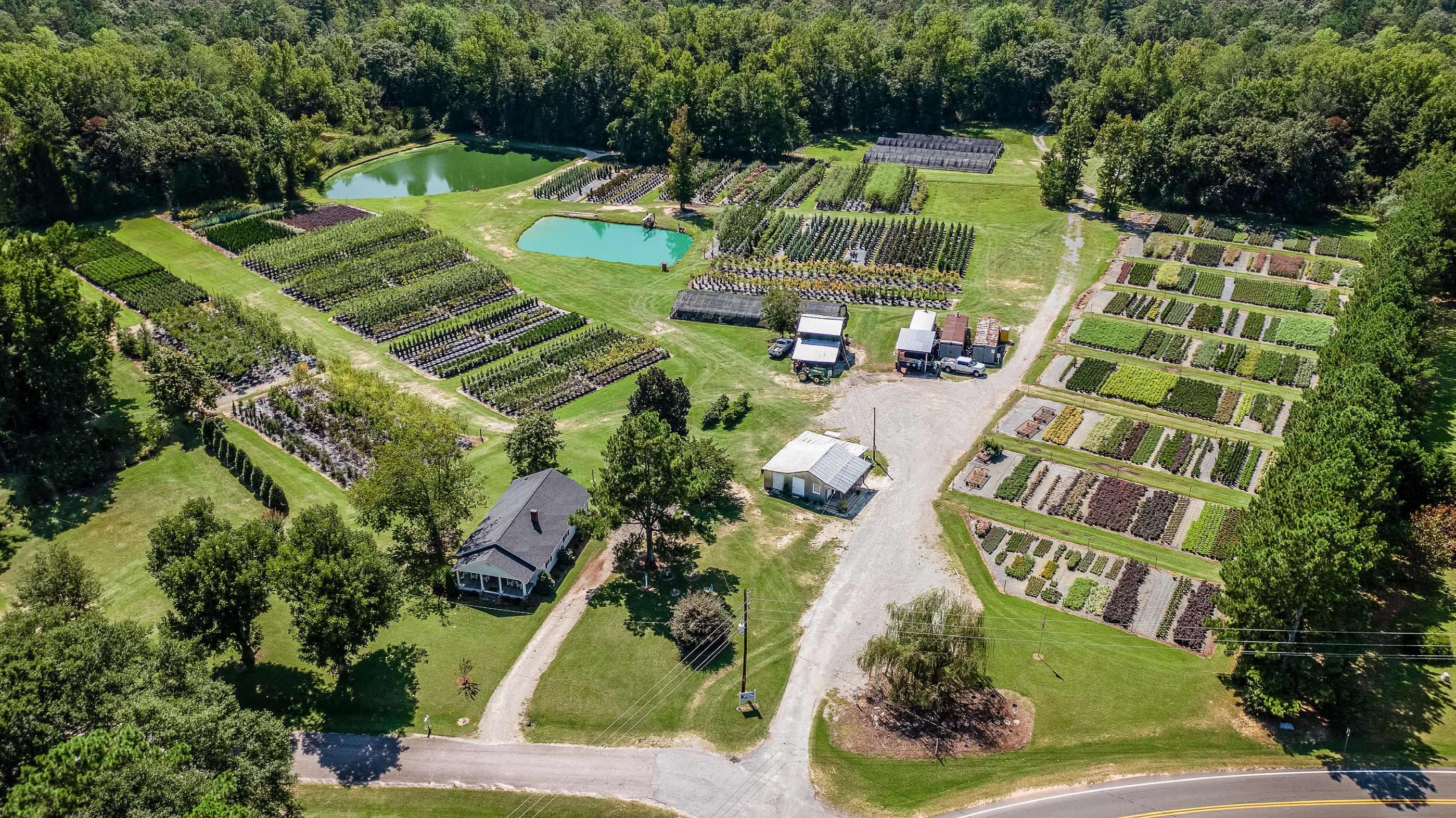

BY CHRIS HOOKS
If one were to ask how to describe, Gail Foushee, owner of Big Bloomers Flower Farm, to say she’s a bright and cheery as a hydrangea in the spring would be selling her short.
For the last 40-plus years, Big Bloomers Flower Farm has been a ‘happy place’ for its customers due in part to lots of hard work and for its huge selection of annuals, perennials, shrubs, and seasonal plants.
“The total culmination of what we do here at Big Bloomers, this is what makes us happy,” said Gail. “Add that up with our amazing customers. I honestly think it’s the customers that truly keep us happy. It’s an exciting time to be in the horticultural business. We feel like we are fortunate to do what we do because we have such a huge variety of plants. That’s why most of our customers come from outside of Lee County.”
Big Bloomers Flower Farm is what some say, “a gardener’s mecca”. It’s not just your run-ofthe-mill retail store, Gail and her husband John, who grow 90% of their plants in their 17-plush retail greenhouses plus five adjacent growing houses on over six-acres of Tramway, NC farmland. The massive Garden Shop is well over 3,000 feet with a very extensive selection of garden-related merchandise such as garden statuary fountains, metalwork, and pottery. Something that many will agree is right up Gail’s alley.
“Growing up, I was always doing something creative,” said Gail. “I made all my clothes, I made curtains, I gardened, my sister and I used to have a craft booth at the local craft show. In fact, years ago, my mom made the comment that I finally found my niche, because that’s what Big Bloomers is for me. My husband John takes care of growing the plants, which accounts for 80% of our sales, but I handle all the purchasing of the
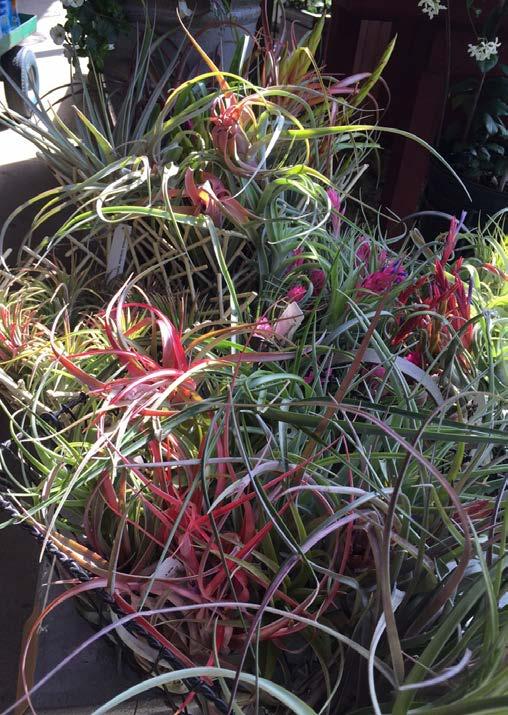
hard goods and the containers. It’s fun for me to try to put together which plants go with certain containers and what accessories will look good with them. It’s something I will never grow tired of. I love plants and what the possibilities are, there’s always something new and different that I can do with them. Big Bloomers has given me a different way to be creative. “
It’s that creativity, uniqueness, that charm that makes Big Bloomers such a special place. In fact, BestThingsNC.com voted Big Bloomers

as one of the 10 Best Garden and Nurseries in North Carolina. Customers from all over will make the short southern trek down U-S 1 to the gardener’s paradise. Loving what you do and sharing your knowledge when helping customers is something everyone at Big Bloomers takes great pride in.
“For me and my staff, when we have a customer come in and say they have a problem in their yard, or they want to do a flower bed or need suggestions, it’s so fulfilling when we help them, because their outdoor space is an extension of their home. If we can help someone have that satisfaction with their yard or a flower bed, it’s kind of fulfills them, and makes them happy to be home or in that area. To me, that’s a win-win for everybody.
Gail knows first and foremost that she and John can’t do it alone, that it’s her staff that is key to Big Bloomers’ overall success.
“We have the most awesome staff,” said Gail.
“I have staff members that have been her for 28 years, 22 years, and several others over 15 years. Whenever you find people like us that love the plants and love what you do as well, those are the people that stay around., It’s for that reason, the staff is just another extension of our family, just like the customers. We are extremely blessed to have such a knowledgeable and passionate staff.”
When asked for one gardening tip for the fall/ winter season, Gail said:
“If I had one main tip for the do-it-yourself gardener for the fall/winter months, use those fall months for planting perennials, shrubs, and trees! The cooler temperatures plus fall rains will help plants get established and ready to bloom come spring time.”
Big Bloomers Flower Farm, a family-owned, family-run, and family-loved business in Sanford, N.C.
And for those that were inquiring, Gail’s favorite color hydrangea – pink.



I mean c’mon. This place is utterly amazing! The variety is outta control! If you can’t find it here, you’re either not looking hard enough or it doesn’t exist. And don’t get me started on their prices. From what I can see… they propagate their own stuff and pass the saving on to working class heroes like me which I’m forever grateful for.
-Mike


It was definitely worth the drive —especially for the perennials. Loved all the native plant options too. But they really had a great selection of everything else too.
-Emmanuelle M.


A huge selection of healthy and well priced plants. You’ll find things here hard to find elsewhere. The staff are friendly and helpful, and you could spend an after just soaking up all the inventory they have to offer. They have everything from houseplants, to fruit trees to perennials.
-Katherine K.


Wonderful selection of flowers, trees, and shrubs. The customer service was perfect! Can't wait for my next visit
-Suzanne S.




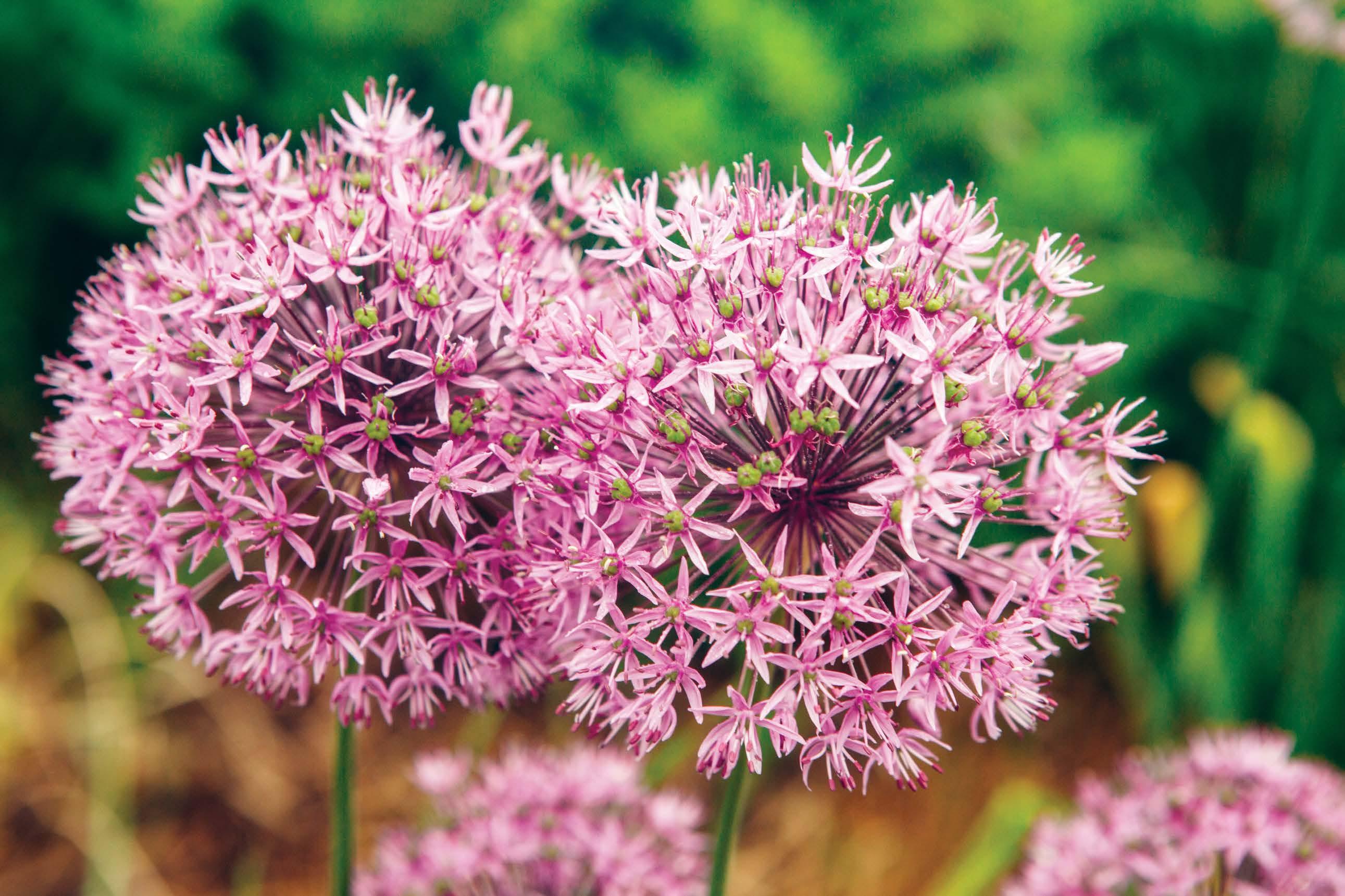
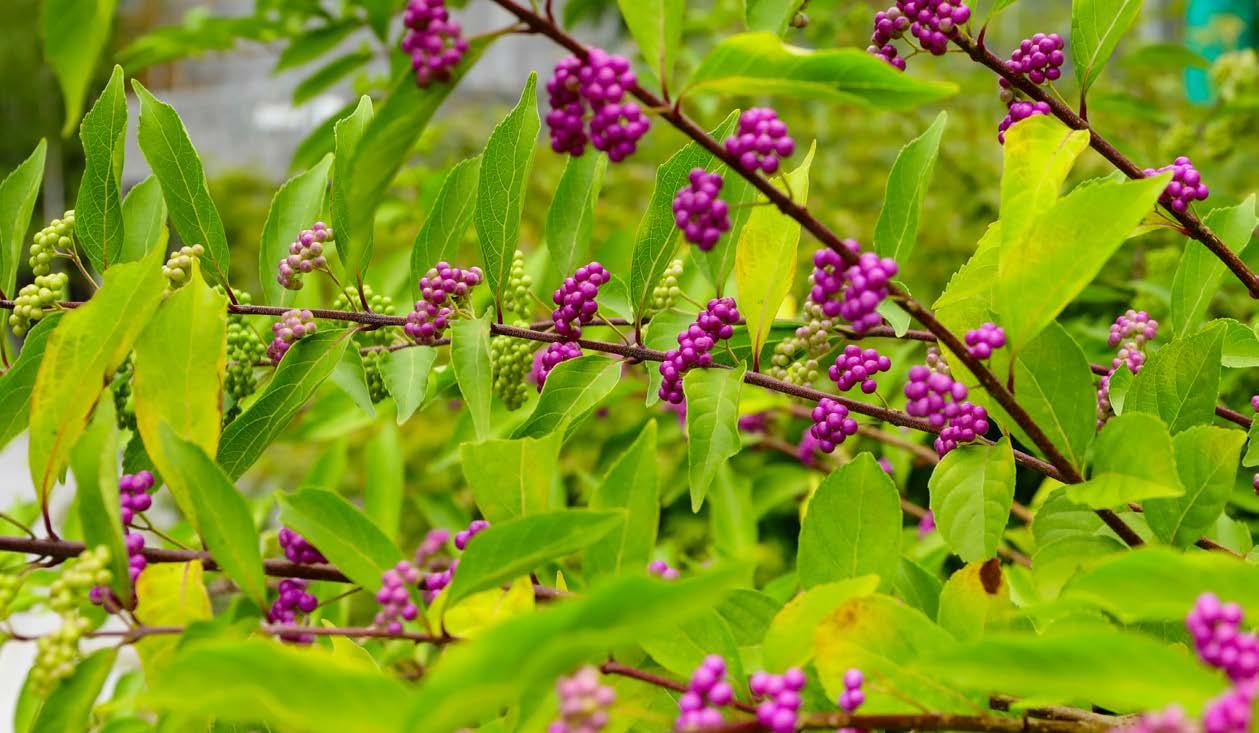
BY MIKE RALEY
The lovely Beautyberry (Callicarpa americana) is one of those underused plants in the landscape. Native to North Carolina and the southeastern United States, it’s one of the most common plants in our region. You can find extraordinary examples at the Raulston Arboretum in Raleigh, the North Carolina Botanical Gardens in Chapel Hill, and the Sarah P. Duke Gardens in Durham. You’ll recognize beautyberry by the clusters of purple berries that wrap around the stems. While there are new varieties with pink and white berries, purple is the native standard. The berries emerge from delicate, wispy flowers in spring, and by early summer, they form and take on a green hue. Usually, the berries start to turn purple, pink, or white in August and last at least through October in our area.
Butterflies, bees, and other pollinators enjoy the nectar from the spring flowers, while birds and other wildlife feed on the berries. Among the bird species that go crazy for native beautyberry fruit are wrens, robins, cardinals, finches, and mockingbirds. The berries provide them with energy and plenty of vitamins to keep them singing. Be sure to keep pesticides away from the beautyberry to protect the wildlife that visit and inhabit your landscape.
I’m trying to remember where I first saw a beautyberry. I don’t recall one in Nashville, though Mr. and Mrs. Sills were the premier gardeners in town at the time, so they may have had one. I planted a beautyberry in my home landscape many years ago, early in my gardening experience. It’s now hidden from view because my
landscape is packed with plants that have grown “fat and happy.”
The native beautyberry is adaptable and easy to grow in sun, shade, or anything in between. It can even be found in wetter areas of North Carolina’s woodlands, but sun and no “wet feet” are ideal. Full sun will likely yield a healthier plant with a heavier fruit set—and, after all, the berries are the main reason we plant them. I see two specimens on my neighborhood walking route: one in mostly sun and the other in deep shade. The shady one is bordered by a centipede section of lawn, which is also in shade. The turf looks a bit thin, but it survives year after year—remarkable, considering it’s not supposed to thrive there. My friends at the Extension Office say that beautyberry has no significant disease or insect problems.
You can find American, Japanese, and Chinese beautyberry, plus several named varieties. The americana variety is native and the best choice, though many non-native species of trees, shrubs, and flowers also thrive in our landscapes. The berries of the native species cluster along the stems, while non-native varieties produce berries that cling randomly—quite a difference in appearance.
My friends at the North Carolina Botanical Gardens in Chapel Hill recommend choosing native plants whenever possible. Native beautyberries seem to do best when planted in masses rather than as single specimens. They are also more eye-catching when grouped together in the landscape.
To plant a beautyberry, dig a hole as deep as the container and twice as wide. Add organic matter like Black Kow and mix it into the soil. Place the plant in the hole with the root ball slightly above ground level, then water well. I plant most shrubs and trees in the fall to give the roots time to develop without the heat stress of summer. If needed, prune beautyberries in late winter. Fertilize sparingly, as too much fertilizer can deter flowering and reduce berry production. After all, without a lot of berries, you might as
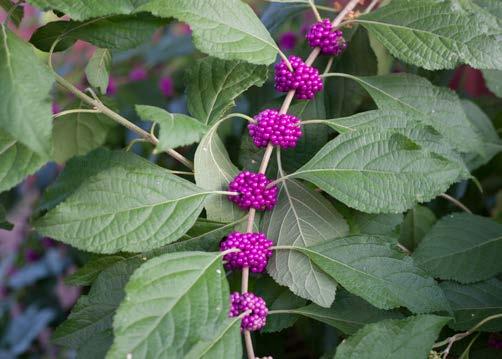
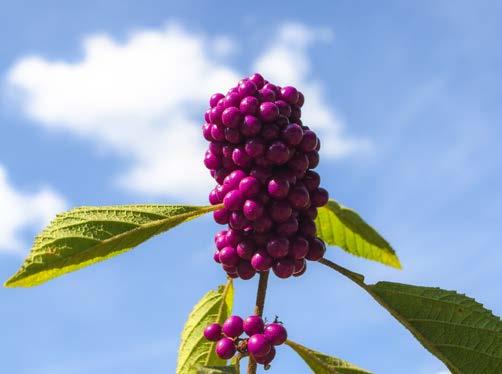
well skip planting beautyberries!
You can also grow beautyberry from seed or cuttings. For more information on propagation, check out Rose Rhode’s book, Plant Propagation, a Primer, available on Amazon. Buy your plants from a local nursery to ensure quality and compatibility with your area. A good relationship with your nursery can help answer any questions you’re bound to have.
Beautyberry fits in well with many other native shrubs and trees, so get creative. If you’re serious about design, consider hiring a landscape architect. Of course, you can always call the WPTF Weekend Gardener for our opinion.
I’ve also heard that beautyberry leaves, though generally nondescript, contain an oil that can be used as an insect repellent. Now, are you sorry you’ve overlooked this colorful native beauty?
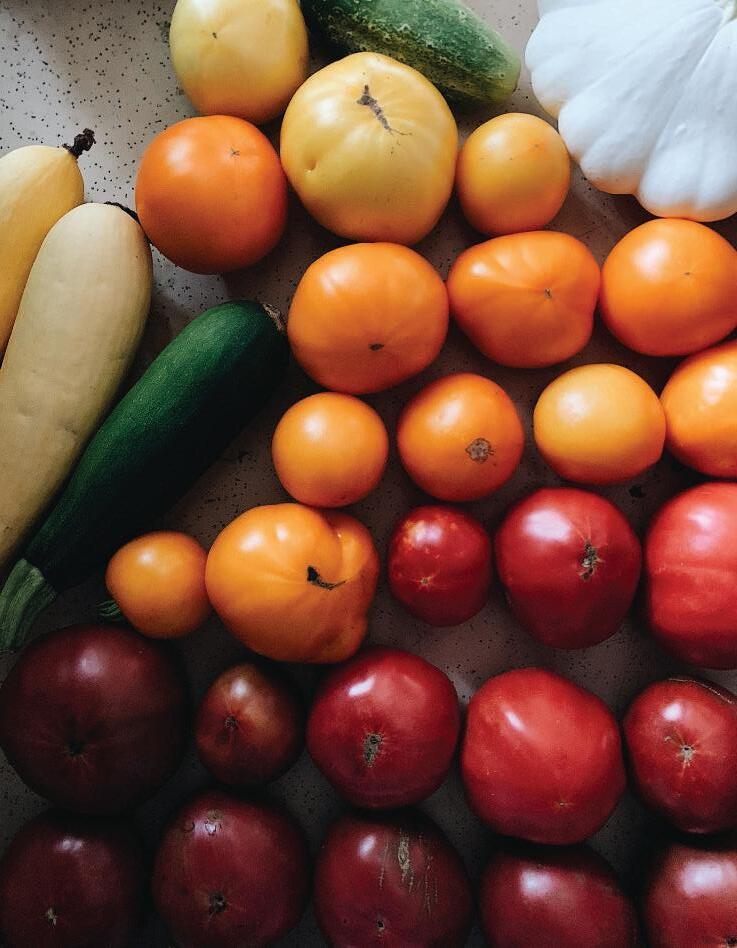









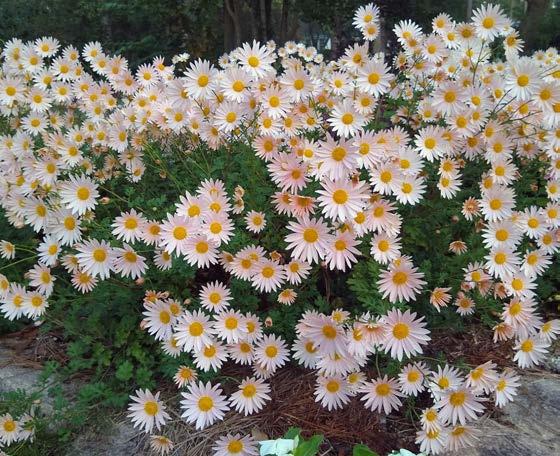
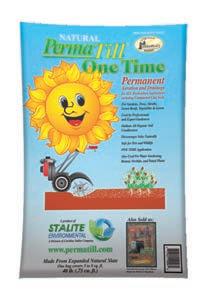
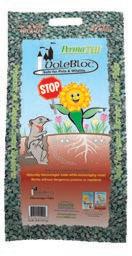


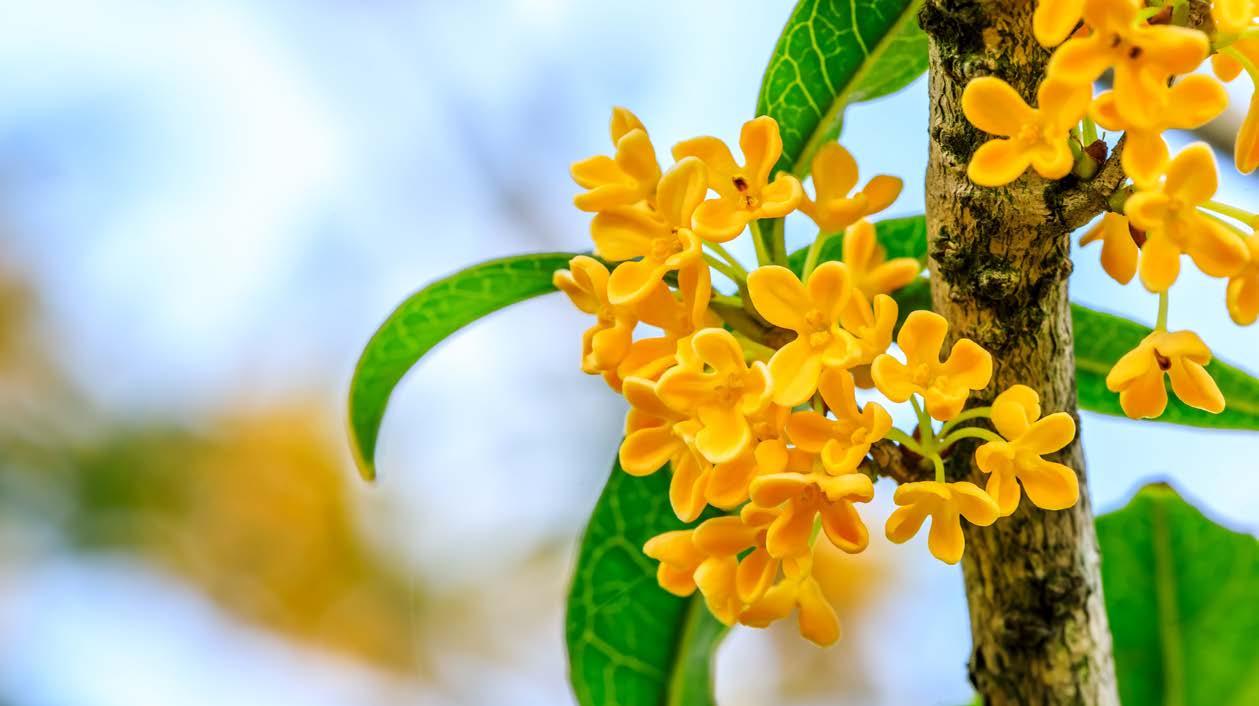
BY MIKE RALEY
Ishould have written about my interest in and love for the Osmanthus fragrans, Sweet Osmanthus or Tea Olive, years ago. We have been promoting its many fine attributes on the WPTF Weekend Gardener for decades. I can’t remember if it was my first co-host, Erv Evans, or Tony Avent as a guest on the old “Ask Your Neighbor” program who first introduced me to the delightful fragrance of this easy-to-care-for shrub. Everything that blooms in North Carolina looked stupendous this spring, and that includes the tea olive, which has produced more flowers and heavenly scent than any year I can remember. The Osmanthus fragrans is one of the most dependable plants I can think of for most parts of the Tarheel state.
While it is not native to North Carolina, it has adapted extraordinarily well to our climate
and soils. It seems to be happy when planted in full sun to part shade. I planted one of mine in partial shade. It has been in the ground for many years and is growing ever taller and wider. It produces flowers in the fall, winter, and spring at intervals. My other one is sitting in too much shade and produces few flowers. The flowers are orange, and it is appropriately named “Orange Supreme.” Our friend Rufus has a 30 ft tall row of the Osmanthus fragrans. They are magnificent and produce a plethora of flower clusters. They don’t grow very fast, so they’re not going to compare to the Leyland Cypress, but they make a fine barrier when established.
The osmanthus is drought-tolerant after it’s established and is forgiving when planted in sand to heavy clay. You can prune the tea olive into all sorts of shapes. Just remember that next year’s
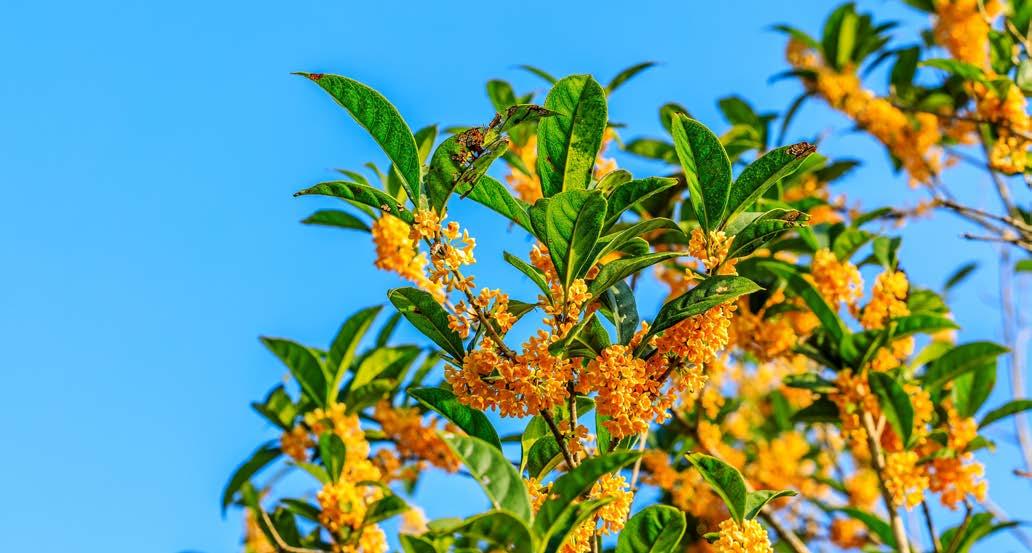
blooms appear on old wood. I don’t prune mine, and I think many plants are happier if they are not pruned unless there is an errant limb that is damaged. You may want to give the tea olive a dose of low-nitrogen, balanced fertilizer in the spring, but follow directions and don’t overdo it. Make sure your tea olive isn’t planted in too wet a space. As for insect pests, you might find some damage from scale or aphids primarily, but again, the tea olive is reliable. Most problems that crop up will result from stress. We all know what that feels like.
The tea olive blooms traditionally in September, October, and November, but it can surprise you. When you least expect it, they might bloom in the winter on relatively warm days and in the spring on a fall-like day. The flowers are small; the size of the flower clusters varies depending on the variety. Usually, the more sun, the more flowers. I remember walking in my neighborhood many years ago when I was suddenly struck by a fragrance I had never encountered. It was overwhelming and smelled like some type of jasmine. Some folks say the scent is more like orange blossoms or peaches. Regardless, I think it is a must-have for most any North Carolina garden. It can be sensitive to frost, so you might find fewer flowers and some cold damage in the mountains. The leaves of this deciduous tree or shrub are sort of holly-like, with some featuring
a bit of a rust-colored sheen in some seasons. In fact, there is a variety with Holly in its name.
When it comes to varieties and named cultivars, there are several others from which to choose. Of course, the standard Osmanthus fragrans is considered the most fragrant of all the tea olives and can produce flowers for up to two months. That may be why it seems to bloom so often during the year. It may grow to 30 feet tall and wide. The aforementioned Holly Tea Olive is much smaller than the standard, growing maybe 8 to 10 feet tall. It has fairly dense foliage and makes a good hedge. There is also the Fortune’s Tea Olive. It is a cross between the Fragrant and Holly varieties, with traits somewhere between the two. You may find these reliable plants at your local garden center, including a new variety named “Fragrant Princess” that blooms in a spectacular way with large clusters of extra-fragrant flowers, all in a small package of 2 to 4 feet high and wide. I haven’t planted one of these, but if you need fragrance for a small space in the landscape or in a container, this diminutive cultivar may work well for you.
Can you tell I love the fragrant tea olive and think everyone should own one? There are other fragrant plants we can incorporate into our landscape, but I think Osmanthus will be one of your best and most reliable friends for many years.
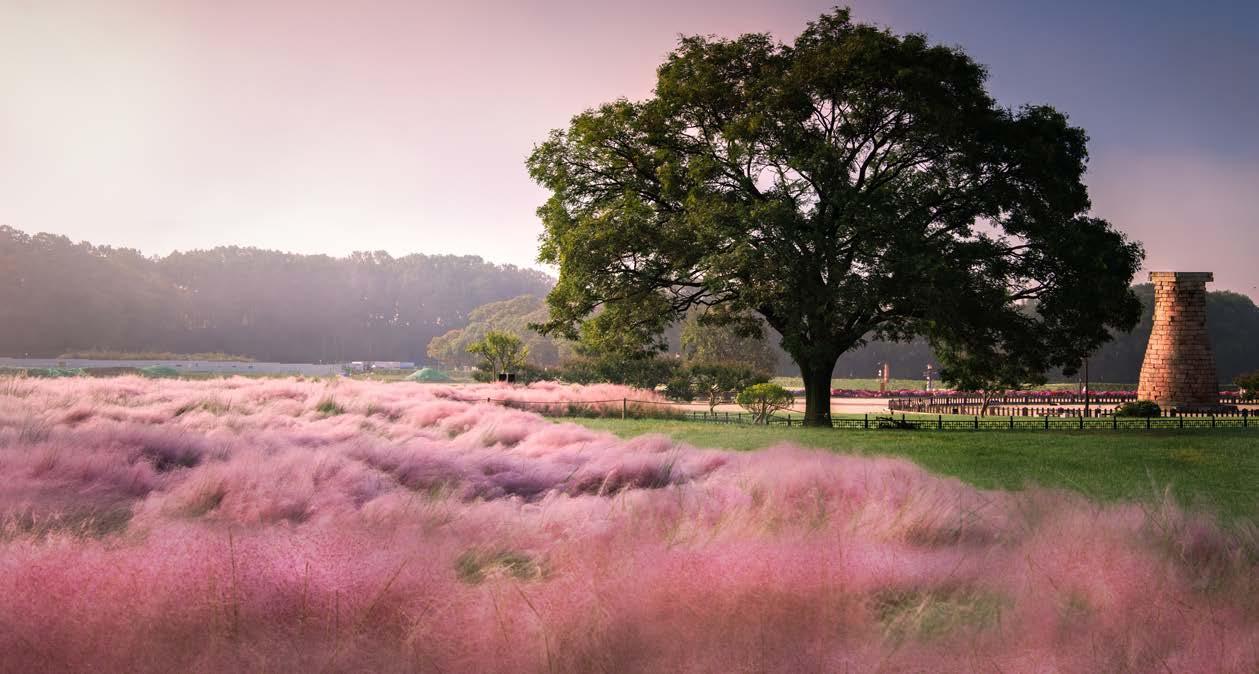
BY MIKE RALEY
Hosting Weekend Gardener over the past four decades has taught me a lot about plants, and there’s still so much to learn. One of my fall and winter favorites is the resilient pink muhly grass. Known as the “mule” among ornamental grasses, this native North Carolinian thrives in various environments, from savannas to prairies and even upland forests.
Planting pink muhly grass in spring or fall is best, as you’ll find it readily available at local nurseries then. In fall, it’s a true showstopper, adding vibrant pink hues to landscapes. Not only does it bring color, but it also helps with soil retention and complements natural garden designs. Typically, these plants grow to about 3 feet tall and wide, with impressive plumes up to 18 inches long—hard for neighbors not to notice!
For optimal growth, plant it in well-drained soil and a sunny spot, with at least six hours of sunlight a day. Like many North Carolina plants,
muhly grass prefers a slightly acidic pH. Adding some Biotone around the roots and tamping down the soil helps settle it nicely.
If you’d like to propagate it, divide your muhly grass clumps in late winter or early spring. Cut the root mass into sections, then plant them to expand your garden or share with neighbors. Trim the plants back to 6 to 8 inches before spring growth begins.
Though drought-tolerant, water young plants when the top inch of soil is dry. Apply a balanced, low-nitrogen fertilizer in early spring, but avoid over-fertilizing. Pests are rare; occasionally, you may see the muhly grass mealybug, but horticultural oil usually does the trick.
You can see pink muhly grass at NC State’s Raulston Arboretum, the North Carolina Botanical Gardens, and the Sarah P. Duke Gardens. Ornamental grasses are popular, and among them, pink muhly remains a North Carolina favorite!


















BY MIKE RALEY
Our friend Rufus delights in discussing his love for rhododendrons. With deep roots in North Carolina's mountain culture, he knows rhododendrons are a common sight along the hillsides in the higher elevations, from Tryon to Sparta and all the way to Murphy. Some listeners of the WPTF Weekend Gardener say they struggle with growing rhododendrons, but these plants actually thrive all over the state and aren’t hard to grow. Many of the rhododendrons people grow are, in fact, azaleas – a subgroup of the genus Rhododendron, as confirmed by our friends at NC State. However, not all rhododendrons are azaleas.
Growing up down east, I don’t remember seeing rhododendrons in my hometown, though azaleas were abundant, with some bushes decades old. I do remember a large, healthy rho-
dodendron at my wife’s childhood home on a lovely farm in Chatham County. I fell in love with that farm not long after I fell in love with Melissa. This rhododendron thrived for decades in what seemed to be its “happy place,” with elegant lavender blooms welcoming guests at one of the home’s back entrances. Though it declined over the past ten years, it reminded me of the gardener’s wisdom: “the right plant for the right place.” That sheltered corner in the morning sun was indeed perfect for it!
So where do rhododendrons thrive? As we know, they’re naturally suited to our extraordinary mountain elevations, growing well in “dappled shade” with moist, well-drained acidic soil. Ideal spots include a slope with partial shade and good drainage—no wet feet for these beauties!
In the central part of the state, however, we
face the challenge of clay soil, which rhododendrons dislike. They prefer the sandy soil of the east or the loamy soil of Rufus’s mountain home. If you have red or beige clay, organic matter is essential. Black Kow or Daddy Pete’s work well. Plant rhododendrons in a shallow hole twice the size of the root ball—worth the effort! As my late predecessor John H. Harris would say, "Don’t put a $50 plant in a $10 hole." If you find a good rhododendron in the fall, that’s the best time to plant it.
Many of us love to fertilize our plants, though rhododendrons don’t need much. Adding organic matter at planting is sufficient, with a light dose of Holly-tone in the spring. Just like azaleas, don’t overdo it.
And while we tend to prune everything in sight, wait to prune rhododendrons until after they bloom.
As long as your rhododendron avoids root rot from soggy soil, the main issues you might encounter include rhododendron borers, lace bugs, weevils, and the occasional deer.
For native rhododendrons, consider the Catawba or Carolina varieties. Plant breeders have also developed heat-tolerant varieties with unique characteristics. Be sure to read the plant description before buying, and check with the experts at our wonderful North Carolina nurseries. And remember, you can always call the Weekend Gardener!
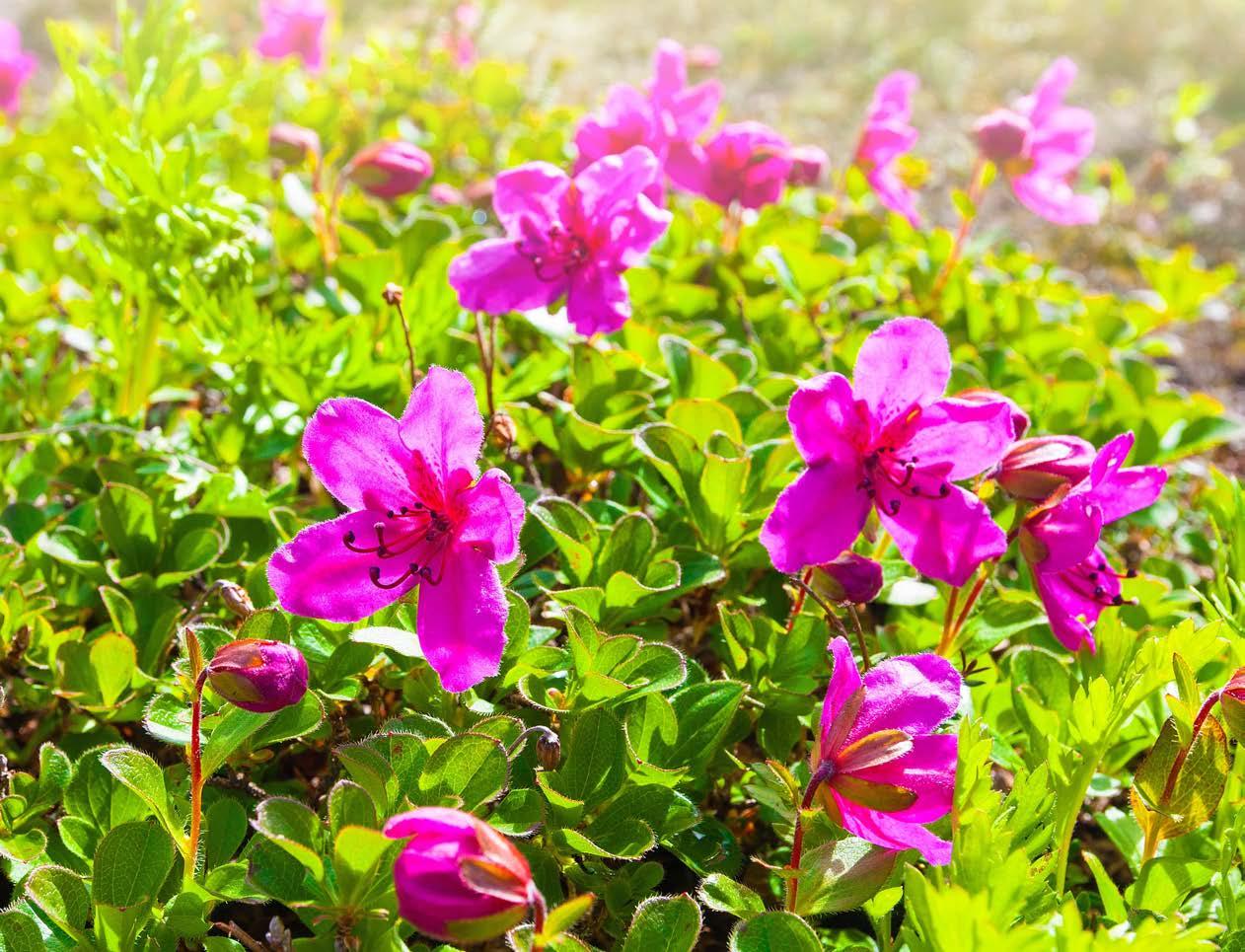
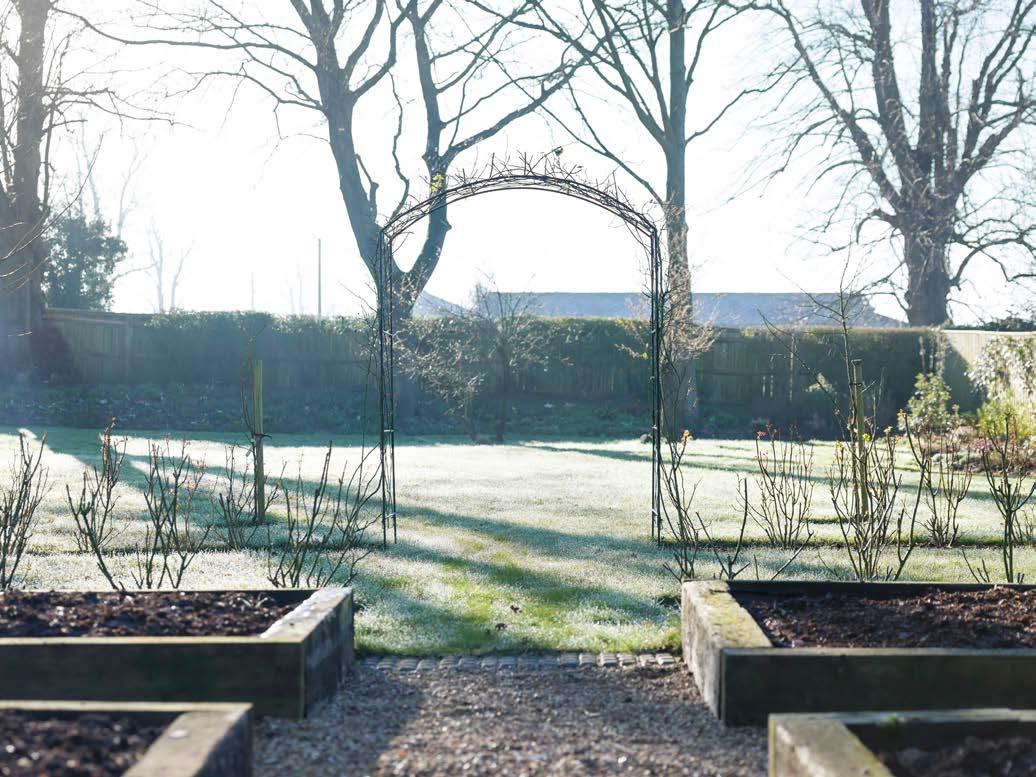
BY SARAH CHRISTAS, N.C. COOPERATIVE EXTENSION
As the temperatures drop and the days grow shorter, it’s time to prepare your garden and landscape for the winter season. Below is some guidance to help homeowners protect their plants and set the stage for a healthy spring. Here are a few essential tips to get started:
Some plants are more vulnerable to frost than others. Be prepared to cover sensitive plants with frost blankets or cloth on chilly nights. For potted plants, bring them indoors or place them in sheltered areas to avoid damage. You can water your plants before a freeze, because hydrated soil
retains heat better than dry soil.
You can still plant cool-season crops such as spinach, kale, and garlic through the fall. Now is also an excellent time to plant perennials, shrubs, and trees. These plants establish roots in the cool season, giving them a head start when spring arrives.
A fresh layer of mulch helps protect plant roots from temperature fluctuations and reduces soil erosion. Spread mulch around trees, shrubs, and garden beds, taking care not to pile it against
tree trunks. Mulching can also help retain moisture in the soil during the winter months.
Fallen leaves provide free, organic mulch. Instead of bagging and discarding them, consider composting leaves or spreading them as a protective layer over garden beds. Mulching leaves with a mower before applying them makes for better decomposition and soil enrichment!
Late fall is a great time to prune dead or diseased branches from trees and shrubs. Avoid heavy pruning, but remove any limbs that could
break in winter storms. Applying mulch around the base of trees and shrubs can protect roots and conserve moisture during the cold months.
Don’t forget about wildlife as you winterize your garden. Leaving seed heads on some plants provides food for birds, and brush piles or leaf litter offer shelter for beneficial insects and small mammals. You can also consider installing bird feeders. This helps support local bird populations through the colder months.
By taking these simple steps, you’ll not only protect your garden through winter but also lay the foundation for a bright, productive spring.
Growing a winter herb garden indoors is a great way to enjoy fresh flavors during the colder months. Herbs like basil, thyme, parsley, mint, and rosemary adapt well to indoor conditions and bring a touch of vibrant green to any space. Start by selecting the right containers—small pots with drainage holes work best, as they prevent water buildup and root rot. Adding saucers under each pot will catch any excess water, and a pot size of 4-6 inches is usually enough to allow for healthy root growth. Place your herb garden in a sunny spot with at least six hours of direct sunlight daily. Southor west-facing windows are ideal, but if natural light is limited, a grow light can provide an effective substitute. Aim to give your herbs 12-14 hours of light each day for best results. For soil, choose a lightweight potting mix that offers good drainage. A blend of compost, perlite, and peat moss works well for indoor herbs, keeping the soil loose and airy. Heavy garden soil, on the other hand, can compact easily and isn’t ideal for container gardening.
Watering is essential but should be done carefully; herbs prefer to be slightly moist rather than
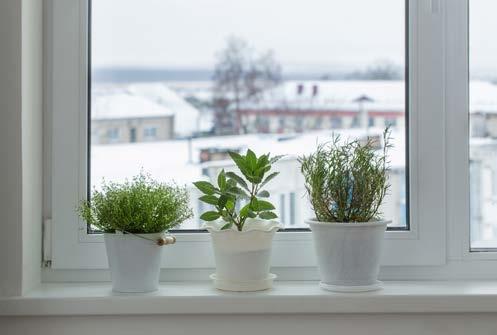
soggy. Check the soil every week or so, and water when the top inch feels dry. Room-temperature water is best, and be sure to empty any standing water from saucers to avoid waterlogging the roots. When it’s time to harvest, pinch off leaves as needed, but avoid taking more than one-third of the plant at a time. This helps encourage bushy growth and keeps the plants healthy and lush. With a bit of care and attention, your indoor herb garden will thrive all winter long, providing fresh ingredients for your kitchen and a touch of green to brighten up your home.

SPONSORED BY
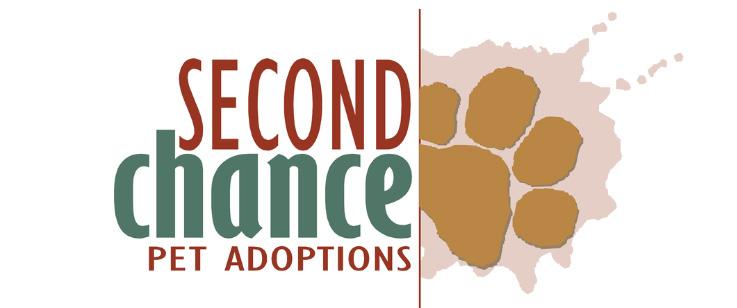
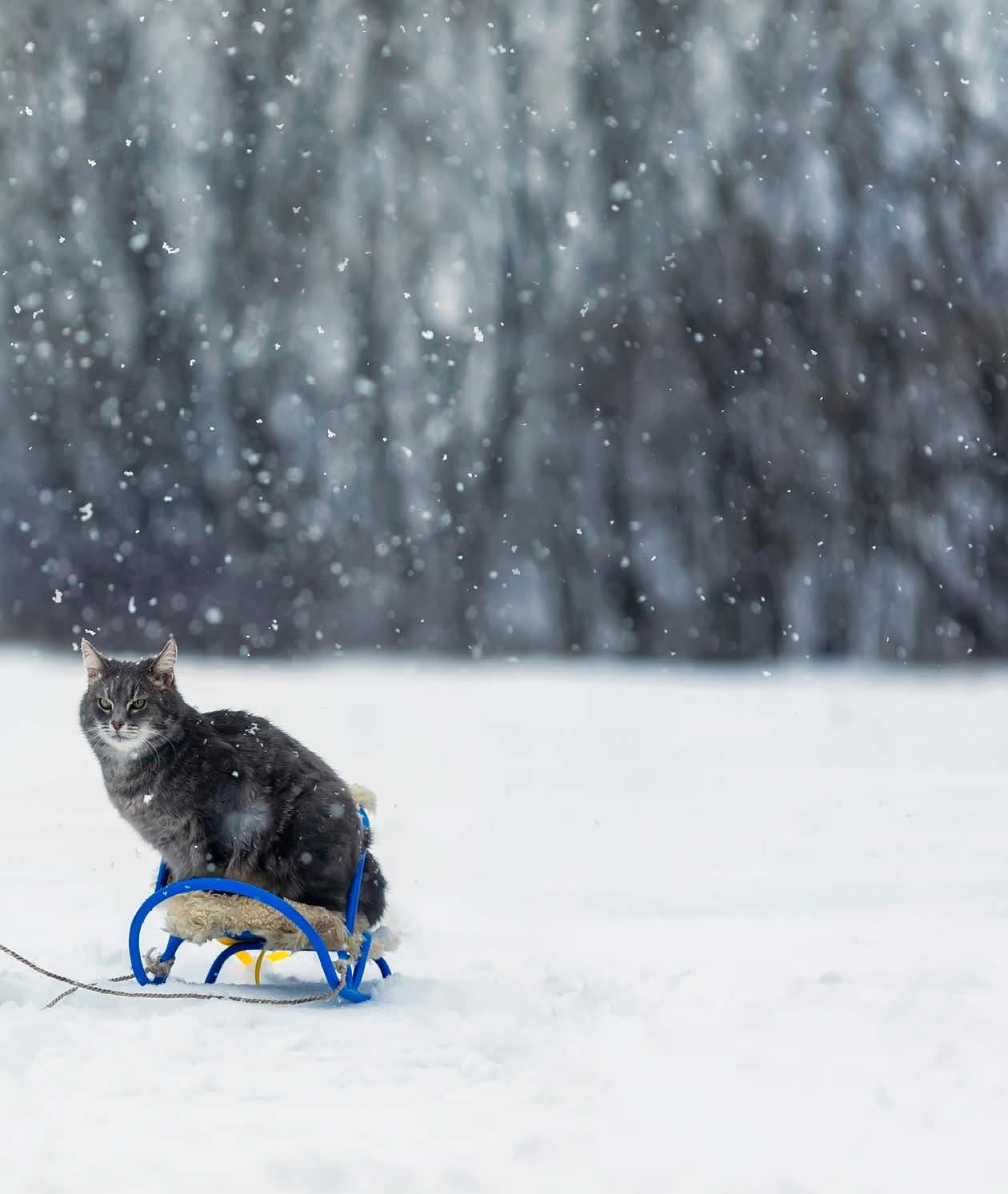
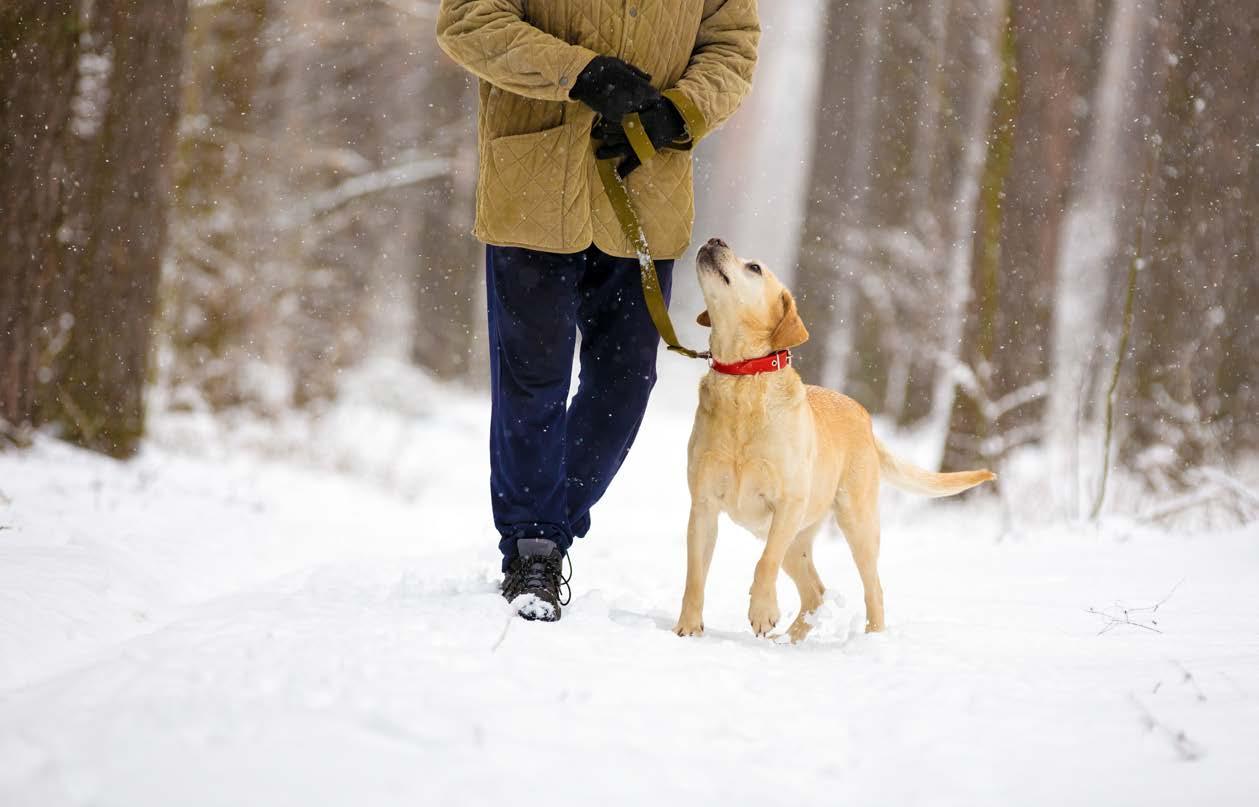
Winter brings its own set of challenges for pet owners, from cold temperatures to harsh winds and wet conditions. As the weather shifts, our pets rely on us to help them stay comfortable, healthy, and safe. While our furry friends may be naturally resilient, they still need extra care during the colder months to stay warm, healthy, and happy. Here’s a guide to keeping pets safe and comfortable in winter so they can enjoy the season as much as we do.
Just like us, pets are susceptible to the cold. If your pet spends a lot of time outdoors, try to limit exposure to the cold, especially when tem-
peratures drop below freezing. For dogs, consider cozy jackets or sweaters to keep them warm, especially if they have a thin coat. Breeds like Greyhounds and Chihuahuas, for instance, benefit from a warm layer since their short fur doesn’t provide as much insulation. However, even larger breeds can feel the cold, so watch for signs of discomfort, such as shivering or whining, which may indicate they’re feeling the chill.
After walks, always dry off your pet thoroughly, especially their paws and belly, as snow, ice, and salt can irritate their skin. If you live in an area where sidewalks are salted, rinse or wipe off their paws to remove any residue, which could be toxic if ingested.
Winter conditions can be rough on pets’ paws. Cold weather, ice, and salt on the ground can lead to cracked or sore paw pads. Before heading out, consider using a paw balm or wax, which acts as a barrier to keep your pet’s paws protected from salt and ice. Alternatively, pet booties can help keep paws warm and shield them from harsh chemicals on the ground. While not all pets take to booties immediately, with a little patience and positive reinforcement, many can become comfortable wearing them.
Regularly check paws for signs of injury, such as redness, cracking, or bleeding. If you notice any issues, apply a petsafe balm and avoid rough terrains until their paws heal. Keep nails trimmed, as longer nails make it harder for pets to walk in the snow, increasing the risk of slips and falls.
fireplace, pets enjoy these comforts too! Create a warm, draft-free area for your pet to rest, away from cold floors or doors. Dog beds with extra padding, or heated pet beds, can be particularly beneficial for older pets or those with joint issues. For cats, cozy blankets or enclosed beds provide a safe and warm hideaway.
If you have a smaller pet, like a rabbit or guinea pig, keep their cages out of drafts and away from direct heat sources. Adding extra bedding or blankets to their enclosures can help keep them comfortable. Remember that pets still need fresh air circulation, so avoid covering cages entirely.

Many pets are less active in winter, so their caloric needs might change. Monitor your pet’s weight and adjust portion sizes if they’re getting less exercise than usual. However, if your pet is a winter-loving breed that spends a lot of time outdoors, they may need more calories to stay warm. Consult with your vet about the best winter diet for your pet’s specific needs.
Although colder weather can make it harder to stay active, regular exercise is essential to keep pets fit and mentally stimulated. For dogs, try shorter but more frequent walks, or get creative with indoor games. Cats can benefit from interactive toys, scratching posts, and even climbing structures to keep them active indoors.
While we all love a cozy blanket and a warm
Winter brings specific risks to our pets, such as antifreeze, which can be lethal if ingested. Even small amounts of antifreeze can be deadly, so clean up any spills immediately and store it safely out of reach. Be cautious with salt or de-icing chemicals around your home, as these can also be toxic. Opt for pet-safe ice melts whenever possible, especially in areas your pets frequent.
Additionally, the cold can exacerbate health conditions, particularly in older pets. Keep an eye on pets with arthritis or other joint issues, as cold weather can make stiffness and discomfort worse. Consider supplements or medications as recommended by your vet, and make sure they have a warm bed to rest in.
For pets that spend significant time outdoors, ensure they have access to a sheltered area that provides protection from the wind, snow, and rain. Outdoor shelters should be insulated, elevated off the ground, and have plenty of bedding to trap body heat. Pets should always have access to fresh, unfrozen water, so consider a heated water bowl if temperatures drop below freezing.

For pets with short fur or those that easily get chilly, a well-fitted winter coat can make outdoor walks comfortable and enjoyable. Look for coats that are water-resistant to help shield your pet from snow and rain. Many coats are designed with insulated layers and reflective strips for added warmth and visibility.
Winter can be tough on paws, especially with salt, ice, and freezing surfaces. Protective boots keep paws safe from cold, sharp ice, and chemical deicers. Look for boots with good traction and secure closures to ensure they stay on while your pet is on the move. If your pet’s not a fan of boots, consider paw wax for added protection.
For smaller pets or those sensitive to the cold, a cozy sweater or hoodie can make all the difference indoors and out. Make sure any sweater is easy to put on and allows for full range of motion. Wool, fleece, and knit materials are popular options that provide warmth and comfort.
With shorter daylight hours, reflective gear is essential for keeping pets visible. Look for collars, leashes, or harnesses with reflective elements, or consider adding a clip-on LED light. This ensures your pet stays visible to drivers and other walkers.
A heated pet bed or blanket offers a cozy retreat for pets to warm up after a chilly outing. These beds are especially beneficial for older pets or those with arthritis. Make sure any heated product you choose is designed specifically for pets to ensure safety.
Cold weather can dry out paws and noses. A moisturizing balm or paw butter helps keep their skin hydrated and reduces cracking from harsh winter conditions. Apply the balm to paws before and after walks for maximum protection.
For rainy winter climates, a waterproof rain jacket is a great addition to your pet’s winter wardrobe. Look for lightweight jackets that cover your pet’s body without restricting movement, and choose one with an adjustable hood or collar for extra rain protection.
For pets who tolerate them, neck warmers or pet scarves can add an extra layer of warmth. Choose soft, pet-safe materials, and make sure they’re loose enough for comfort and safety. These accessories can help keep your pet comfortable, safe, and stylish all winter long. With the right winter gear, both you and your pet can enjoy the season together, no matter the weather!








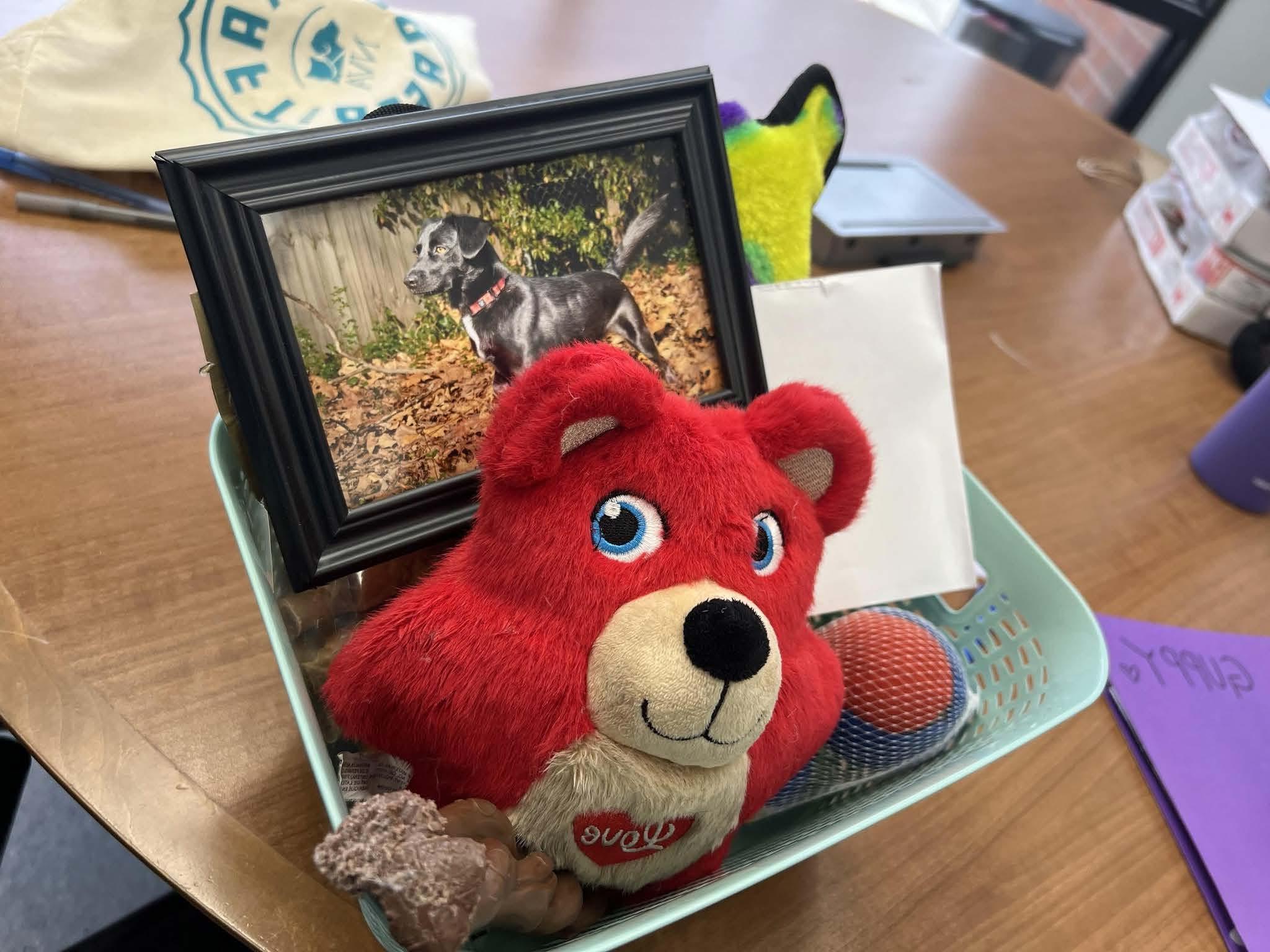






















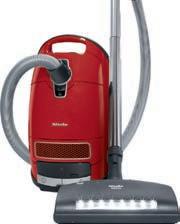





































Winter’s chill can quickly turn your home into an icebox if it’s not properly insulated. Fortunately, there are simple and affordable DIY hacks to keep the cold out and the warmth in. Here are the best insulation tips for a cozy winter:
Windows are a common source of heat loss. Start by adding weatherstripping around frames, and use caulk to fill any small gaps. For an extra layer of warmth, install thermal curtains or attach bubble wrap directly onto the glass. This simple step traps cold air outside, keeping rooms warmer.
Doors, especially exterior ones, can let in drafts. Apply adhesive foam strips along the frame to seal gaps, and add a door sweep at the bottom. For an inexpensive option, use a rolledup towel as a makeshift draft stopper. Keeping doors draft-free can significantly reduce heat loss.
If you have an older water heater, insulating it can prevent heat loss, saving energy and low-
ering your heating bill. Purchase an inexpensive water heater insulation blanket from a hardware store, wrap it tightly around the heater, and secure it with duct tape. Be careful to leave vents uncovered for safety.
Electrical outlets on exterior walls can be sources of cold air. Install foam gaskets behind outlet covers to block drafts. These are easy to find at home improvement stores and take only minutes to install.
Hardwood and tile floors can make rooms feel colder. Adding rugs or carpets provides insulation and reduces heat loss through the floor. Choose thicker rugs for better warmth retention.
Heat rises, so a poorly insulated attic can be a major source of warmth loss. Lay down rolls of fiberglass insulation, or if possible, install spray foam insulation for better coverage.
With these DIY insulation hacks, you can keep your home warmer this winter without a hefty heating bill!








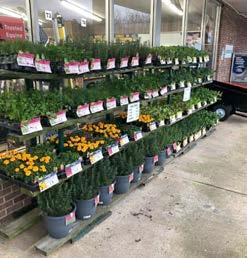

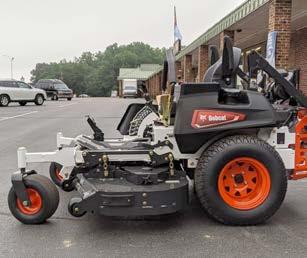
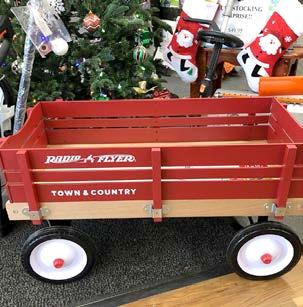

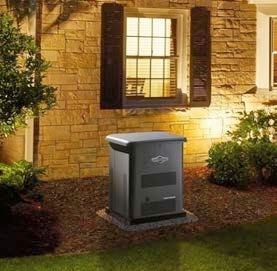



Winter storms can lead to power outages that last hours or even days, so being prepared is essential. A well-stocked emergency kit can help keep you safe, warm, and comfortable while you wait for the power to come back on. Here’s what to include in your winter storm emergency kit:
Without power, keeping warm is a top priority. Include thermal blankets or sleeping bags rated for low temperatures, which are designed to retain body heat. Wool blankets and extra winter clothing, such as socks, gloves, and hats, are also essential. Hand warmers and foot warmers provide extra heat and are compact and easy to store in your kit.
If you have a wood-burning fireplace or stove, stock up on dry firewood or pellets, but ensure it’s used safely and monitored. You may also want a safe indoor heater, like a propane or kerosene heater rated for indoor use—just make sure to follow all safety guidelines.
Since winter days are shorter, you’ll need reliable lighting options. Flashlights and battery-operated lanterns are essential, with extra batteries included. LED lanterns are a good choice as they provide ample light and use batteries efficiently. Avoid candles if possible, as they pose a fire hazard, especially if you have pets or children.
Plan for at least three days’ worth of non-perishable food and water. High-energy foods like granola bars, canned goods, peanut butter, and dried fruits are great for emergencies. Don’t forget a manual can opener! For water, plan on one gallon per person per day, and store it in a cool, dark place.
To stay informed about weather updates and emergency instructions, keep a battery-powered or hand-crank radio in your kit. A portable char-
ger or power bank is also helpful to keep your phone charged, especially if you’re able to conserve power and use your phone for critical communication.
A first aid kit is essential for any emergency situation. Your kit should include basics like bandages, gauze, adhesive tape, antiseptic wipes, and pain relievers. If anyone in your household has prescription medications, include a supply in your kit as well. Additionally, consider including hand sanitizer and masks for hygiene.
If an outage lasts several days, hygiene becomes a concern. Add basic items like toilet paper, moist towelettes, garbage bags, and disinfecting wipes. If you have infants or pets, make sure to include necessary supplies like diapers, baby wipes, pet food, and waste disposal bags.
Include other useful items that could make a power outage more manageable. Tools like a multi-tool or Swiss Army knife, duct tape, and waterproof matches can be incredibly helpful. If you wear glasses, consider adding an extra pair, and make sure you have copies of important documents in waterproof packaging.
Finally, don’t overlook items to keep spirits up and boredom at bay, especially if you have children. Pack playing cards, books, or board games to help pass the time.




•
•
•

















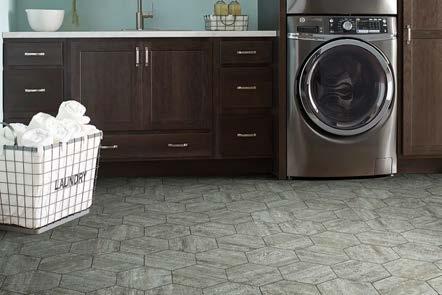
















BY LARISSA RUNKLE
Home maintenance in the winter? You heard us right, snow dogs. Just because flurries may be drifting across the yard and temperatures are plummeting doesn’t mean there isn’t plenty to do indoors to keep your home in peak condition.
Your winter home maintenance tasks may vary depending on where you live, but we’ve compiled expert advice from around the country to bring you this must-do list.
These maintenance tips will save you money on energy bills and prevent expensive repairs down the road. Some are DIY-friendly, while others might need professional help. Either way, it’s time to get started before the next winter storm hits. (Hot toddies not included.)
If you haven’t done this one yet, then you’re
literally throwing money out the window.
“Most windows develop an air gap over time, which can cause as much as 40% energy loss for heating and cooling,” says Cristina Miguelez, remodeling specialist with Fixr. “Caulking that gap can make a big difference in your heating bills and comfort level.”
Start by removing old caulking, then apply fresh caulk along the frame. Use gloves and smooth the caulking with your fingertips for the best results.
Winter storms can be hard on roofs, and small problems can turn into big, costly repairs.
“It’s essential to check for missing shingles, roof tiles, and damage as part of winter roof
maintenance,” says Amanda Wynn of Rampart Roofing. “Repairing existing leaks will prevent small problems from becoming big and expensive problems later on.”
For safety, it’s best to call a professional to inspect and repair any issues rather than tackling this in the cold yourself.
Using a fireplace? Then it’s time to clean it. Creosote buildup in chimneys can cause dangerous fires.
“If you use your fireplace, you need to clean it,” says Miguelez. “Creosote builds up on the chimney walls, and a stray spark could cause it to catch fire.”
This is one job best left to the pros, who have the right tools and experience for the task.
Your Christmas tree isn’t the only one to keep in check this winter. Trees near your house should be trimmed to prevent falling branches from causing damage.
“Temperature fluctuation, ice, heavy snow, and other winter conditions can weaken your trees,” advises Jason Metzger, VP of risk management at PURE Insurance. “If they fall, they could injure someone, knock out electricity, or damage your home and other property.”
It’s wise to have your trees inspected early in the season.
If you have a sump pump in your basement, it’s crucial to test it before the winter rains.
“Make sure to test your sump pump every few months to avoid a costly flooded basement disaster,” says Diana Rodriguez-Zaba, president of ServiceMaster Restoration by Zaba.
Ensure the pump’s mechanism moves freely, and clear the basin of debris that could clog the valve or discharge pipe.
Frozen pipes are a common winter problem,

but you can take steps to prevent it.
“Allow a small trickle of cold water to run from your faucet and open under-sink cabinet doors to keep warm room air circulating around pipes,” says Doyle James, president of Mr. Rooter Plumbing. “Disconnect hoses, drain your sprinkler system, and make sure outdoor faucets aren’t leaking.”
Did you know ceiling fans can help heat your home in the winter? By reversing their direction, fans push warm air back down into the room.
“Hot air always rises, and ceiling fans are uniquely designed to direct airflow exactly where you need it most,” says Richard Ciresi, franchise owner of Aire Serv. “When you flip your fan’s switch to reverse, the fan moves in a clockwise direction, pushing hot air down into your rooms.”
This one’s simple, but effective—add mats at entrances to shield your floors from winter salt and grime.
“It’s not the water you’re worried about; it’s the sand and salt—since those can really harm wood or stone floors,” says Miguelez.
Following these essential winter maintenance steps will help you keep your home cozy, safe, and ready for the season ahead.


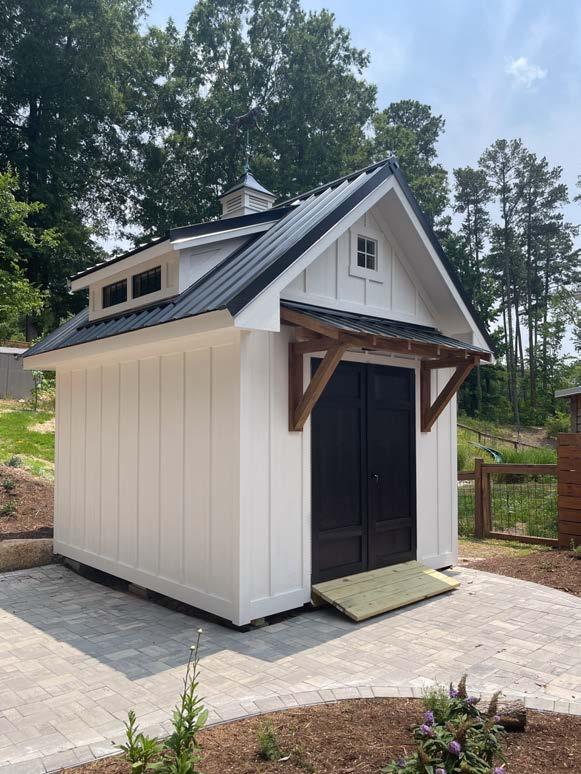
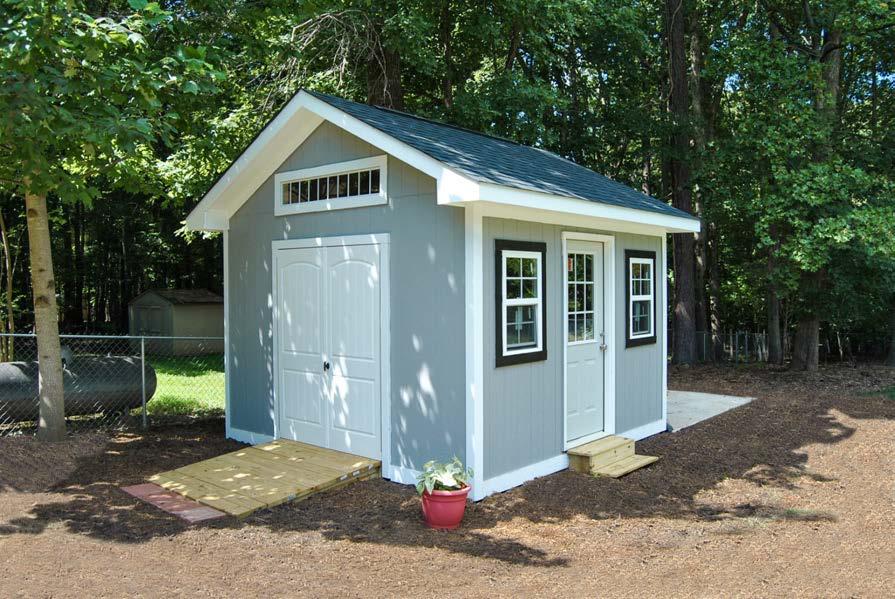



A well-stocked, welcoming bathroom is the secret to a great guest experience, whether at a hotel or in your home. Here’s how to prep your bathroom for a cozy, guest-friendly stay.

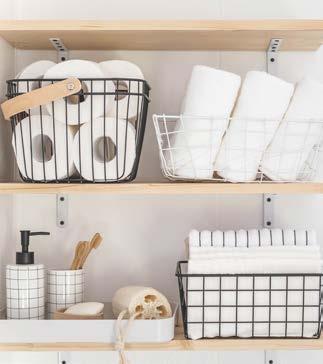
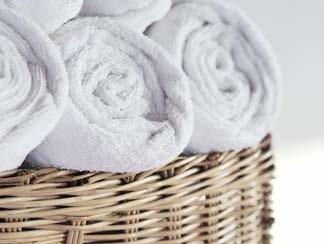
• Start by giving your bathroom a deep clean—it’s the first step to creating a spotless sanctuary!
• Wipe down every surface: sink, toilet, shelves, and countertops.
• Use specific cleaners for trouble spots: tile spray for the shower, toilet bowl cleaner, and glass cleaner for mirrors.
• Mop the floors once you’ve finished surfaces.
• Empty the trash bin to keep it all pristine.
TIP: For a streak-free mirror, use a newspaper instead of a rag!
• If your guest bathroom is usually shared or used by the family, take out any clutter that doesn’t serve your guests. Remove half-used products, personal items, and kids’ bath toys.
• Create space for guests’ belongings with a few adhesive hooks or a compact storage cart.
• Offer a spot for grooming: Adding a small end table or vanity space keeps guests from shuttling back and forth between rooms.
TIP: Use a bucket to gather any items that need temporary relocation. Once guests leave, you can easily put them back!*
• Now that everything’s clean, make sure essentials are wellstocked:
• Toilet paper and hand soap – plenty of it!
• Fresh towels: Leave a luxurious set for guests—think soft bath towels, hand towels, and washcloths. Hang them neatly to show they’re fresh and ready.



Nothing says “thoughtful host” like a kit of essentials. Stock your bathroom with travel-sized items, just in case guests forget something:
» Toothpaste
» Shampoo and soap
» Cotton balls and swabs
» Pain medicine and floss
» Disposable razor and nail clippers
» Hair dryer and hair ties
• Make sure the bath and shower area is inviting:
• Replace the shower curtain if it looks tired.
• Check the showerhead—if it’s leaky or weak, swap it out.
• Add a plush bath mat for a cozy feel.
TIP: Include a few extra touches, like loofahs, bath salts, or spa-worthy extras to give it that hotel feel.*
To make your bathroom truly inviting, focus on little details:
• Clean any windows to brighten the space.
• Add a pop of freshness: A candle, a vase of flowers, or even some room freshener makes a big difference.
• Consider décor: A small plant, vintage basket, or seashells make the space feel warm and polished.
• Set out a bathrobe and slippers if you have them—your guests will love the extra luxury!
With these touches, your bathroom will be a cozy, functional sanctuary for guests, ensuring they feel right at home!



Winter brings unique challenges for your car, starting with your battery. At King’s Auto Service, we recommend putting your battery at the top of your winter prep list. Extreme cold can weaken it, so avoid that dreaded silence when you turn the key—get a battery check at King’s today.
And don’t forget your A/C, even in winter! A reliable air conditioning system is essential for defogging your windshield on chilly days.

Driving a Prius or another hybrid? King’s certified hybrid technicians specialize in high-voltage battery pack diagnostics and replacements for less than dealer costs—an important service as you approach 150,000 miles.
Call King’s today to schedule your courtesy battery analysis. Conveniently located at 1039 North West Street in downtown Raleigh or online at KingAutomotive.net. King’s Auto Service—Raleigh’s trusted auto care since 1946.

As the holiday season approaches, there’s no better way to embrace the festive spirit than by transforming your home into a cozy winter wonderland. Decorating for the holidays is about setting the mood, capturing the warmth of the season, and creating memories that last. Here’s the ultimate guide to decking your home with charm, sparkle, and holiday cheer!
Before diving into the decorations, pick a theme that suits your style. Whether it’s traditional red and green, rustic farmhouse, glistening winter wonderland, or vintage-inspired, choosing a theme will help you pull everything together seamlessly. Once you have a theme in mind, gather color-coordinated decorations, ribbons, and other accessories to ensure a harmonious look throughout your home.
Your entryway sets the first impression, so make it welcoming and festive! Start by hanging a beautiful wreath on your front door, decorated with pine cones, berries, or ornaments matching your theme. Add a small Christmas tree or garland around the door frame for extra charm. If you have space, place a welcome mat with a holiday motif and a few potted poinsettias or lanterns with LED candles along the pathway. These small touches make guests feel the holiday spirit as soon as they arrive.
One of the most impactful ways to decorate is with garlands and holiday lights. String lights along mantels, staircases, and windows to create a warm and inviting glow. LED lights come in different colors and styles—from warm white to
multicolor—and can be used inside and out. For a natural touch, consider adding greenery with a fresh pine or cedar garland. Enhance it with ribbons, mini ornaments, or berries that tie into your chosen theme. Draping garlands over the fireplace and across door frames instantly transforms your home.
The Christmas tree is often the focal point of holiday decorating. Start by stringing lights from the base to the top for an even glow. Add garlands or ribbons next, spiraling them around the tree, followed by ornaments in coordinating colors and textures. Mix in classic ornaments with newer ones to give the tree a collected, unique look. Place larger ornaments near the base and smaller ones closer to the top. To finish, add a tree topper, whether a classic star, angel, or something fun that complements your theme. A tree skirt, festive baskets, or a blanket at the base completes the look and hides the stand.
Create a cozy holiday atmosphere by adding festive pillows, throws, and blankets to your living room. Opt for textures like plaid, faux fur, or knit blankets to add warmth and comfort. Arrange pillows with holiday patterns or slogans on sofas and chairs, keeping with your color scheme. Add scented candles or potpourri with seasonal scents like pine, cinnamon, or vanilla for an extra cozy touch.
The dining table is where loved ones gather, so make it special. Start with a festive table runner or tablecloth that complements your theme. Add a centerpiece—whether it’s a vase filled with pine branches, a bowl of ornaments, or a small holiday arrangement. Surround it with candles in varied heights to add warmth and dimension. Use decorative chargers, holiday-themed dinnerware, and cloth napkins with simple napkin rings or sprigs of holly. If you’re hosting, add place cards for an
extra-personal touch.
If you have kids, set up a little holiday nook just for them. Create a corner with miniature Christmas trees they can decorate with soft, unbreakable ornaments. Consider a holiday-themed bookshelf or toy area where they can display holiday crafts and stories. Having a dedicated space makes the season feel even more magical for little ones.
The kitchen is often the heart of the home during the holidays. Add subtle decorations that won’t get in the way of your cooking and entertaining. Small wreaths on cabinet doors, holiday-themed dish towels, and a bowl of seasonal fruit or ornaments on the counter can give the kitchen a festive feel. You might even hang a garland or some string lights around the kitchen window. A holiday cookie jar filled with treats is a delightful touch, especially if you have little ones around.
Complete the holiday atmosphere by appealing to the senses. Fill your home with seasonal scents using candles, essential oils, or simmer pots with oranges, cinnamon sticks, and cloves. Fresh pine, cedar, or eucalyptus can also add a lovely fragrance. And don’t forget the holiday music! Create a playlist with your favorite holiday tunes to keep the festive energy flowing as you decorate and entertain guests.
The finishing touches are what make your decorations feel complete. Sprinkle in some small details, like miniature Christmas figurines on shelves, holiday coasters on coffee tables, or a bowl of candy canes by the door for guests. Swap out everyday frames with family holiday photos from years past to add a sentimental touch. A few decorative items on bathroom counters or holiday-themed hand towels can add charm even in small spaces.
Before you replace your Hybrid Battery Pack call King's for


ATTENTION HYBRID OWNERS!
ATTENTION HYBRID OWNERS!
If you're currently driving a Prius or any other hybrid vehicle, the certified hybrid technicians at King's are ready to diagnose and give you available options for a high voltage battery pack replacement for less than the dealer will charge for a replacement. Call King's to schedule a courtesy battery analysis.
ATTENTION HYBRID OWNERS!
King’s Auto Service can refurbish your battery pack for less than half the cost of a replacement at the dealer. Why go to the dealer when King's Auto Service can refurbish your existing battery pack for less than half the cost! Prius and hybrid owners …call King's Auto Service today to schedule your courtesy battery analysis. King's will also inspect your battery, cell balance and antifreeze during this important check up.
are ready to diagnose and give you available options for a high voltage battery pack replacement for less than the dealer will charge for a replacement. Call King's to schedule a courtesy battery analysis. (919) 834-0748
King’s Auto Service can refurbish your battery pack for less than half the cost of a replacement at the dealer. Why go to the dealer when King's Auto Service can refurbish your existing battery pack for less than half the cost! Prius and hybrid owners …call King's Auto Service today to schedule your courtesy battery analysis. King's will also inspect your battery, cell balance and antifreeze during this important check up.
King’s Auto Service can refurbish your battery pack for less than half the cost of a replacement at the dealer. Why go to the dealer when King's Auto Service can refurbish your existing battery pack for less than half the cost! Prius and hybrid owners …call King's Auto Service today to schedule your courtesy battery analysis. King's will also inspect your battery, cell balance and antifreeze during this important check up.




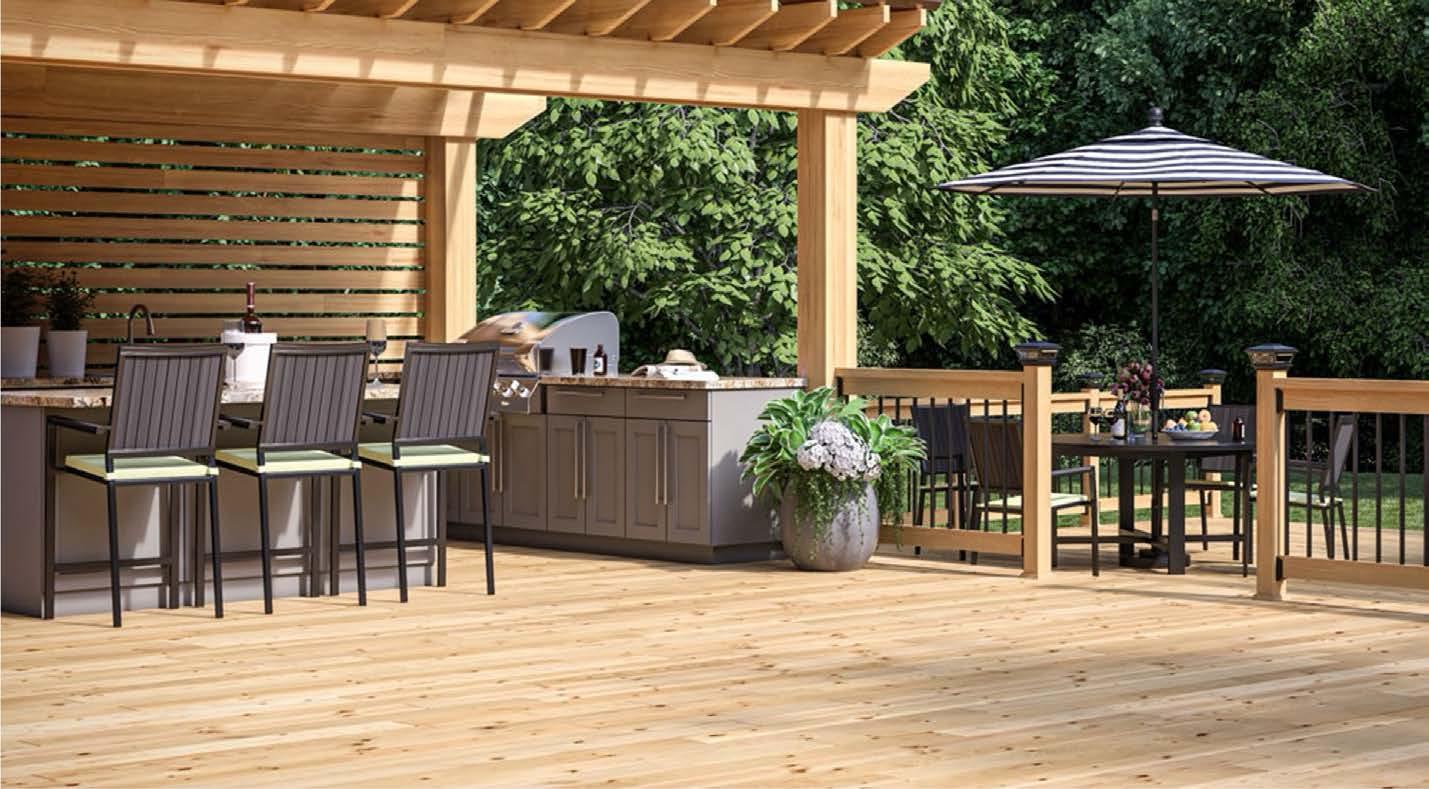



OUR PENETRATING SEALANT COMPLETELY ELIMINATES THE EFFORT & EXPENSE OF FREQUENT TOPCOATS















SCAN TO BOOK A QUOTE ONLINE SPRING SPECIAL SAVE % + 12 MONTHS NO INTEREST FINANCING AVAILABLE FOR QUALIFIED CUSTOMERS




• 4.7 STAR GOOGLE RATING • LOCALLY OWNED & OPERATED • 100% EMPLOYEE INSTALLERS • SAFE & NON-TOXIC PRODUCTS • SEALS FROM THE INSIDE-OUT • NOT SLIPPERY WHEN WET
• 25 YEAR WARRANTY 91 91 6301







DECKS DOCKS CABINS S PAVERS CONCRETE

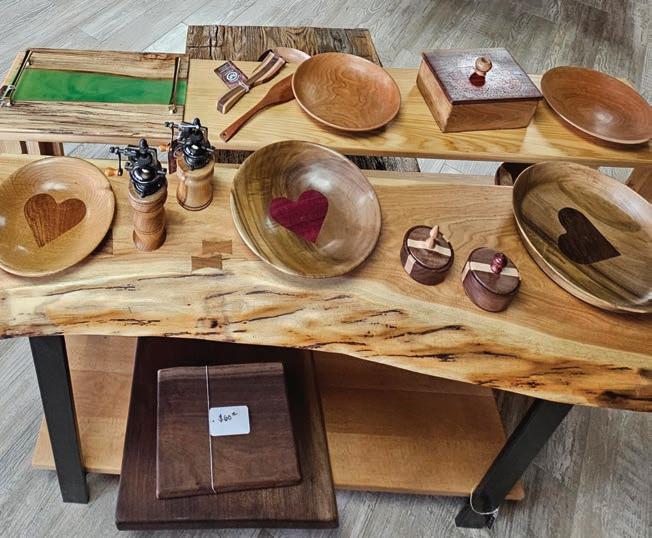


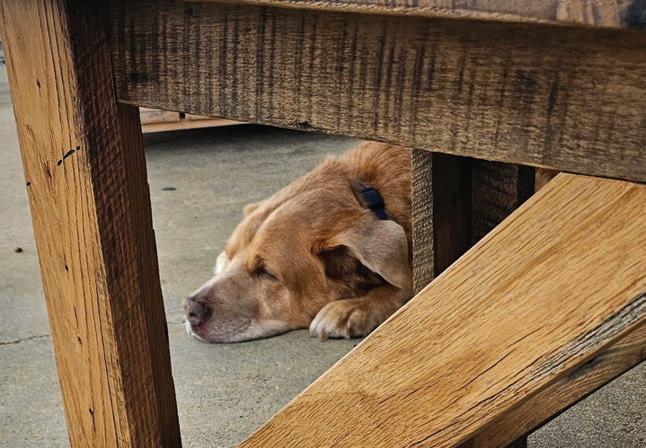






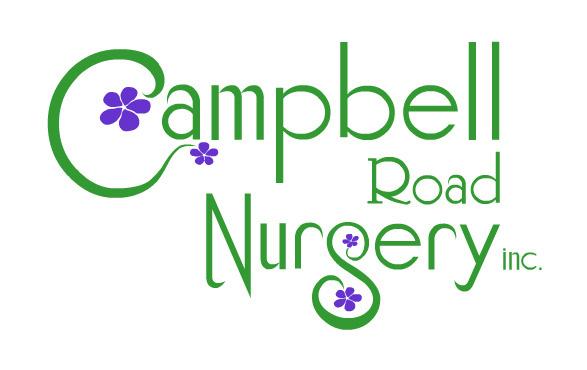
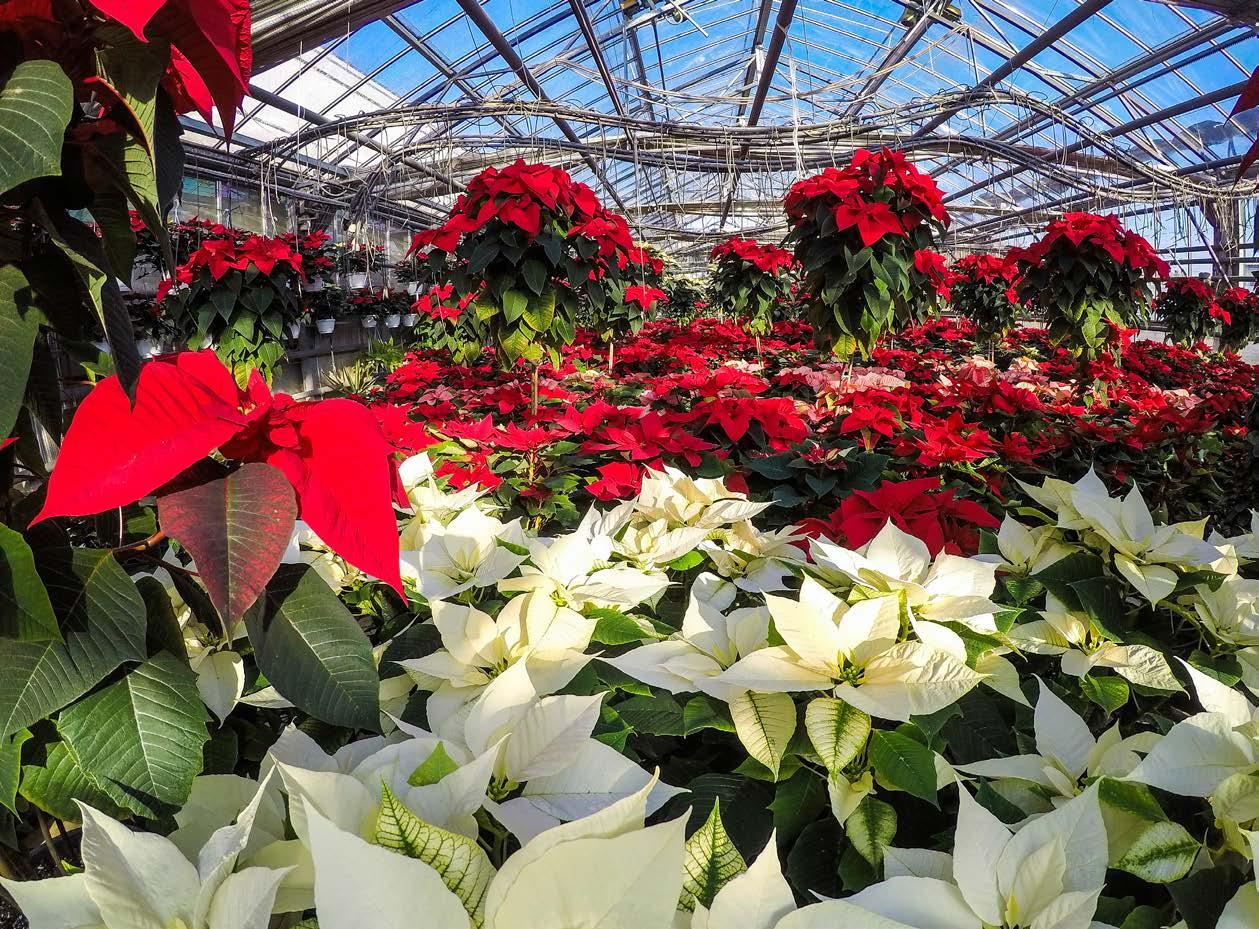

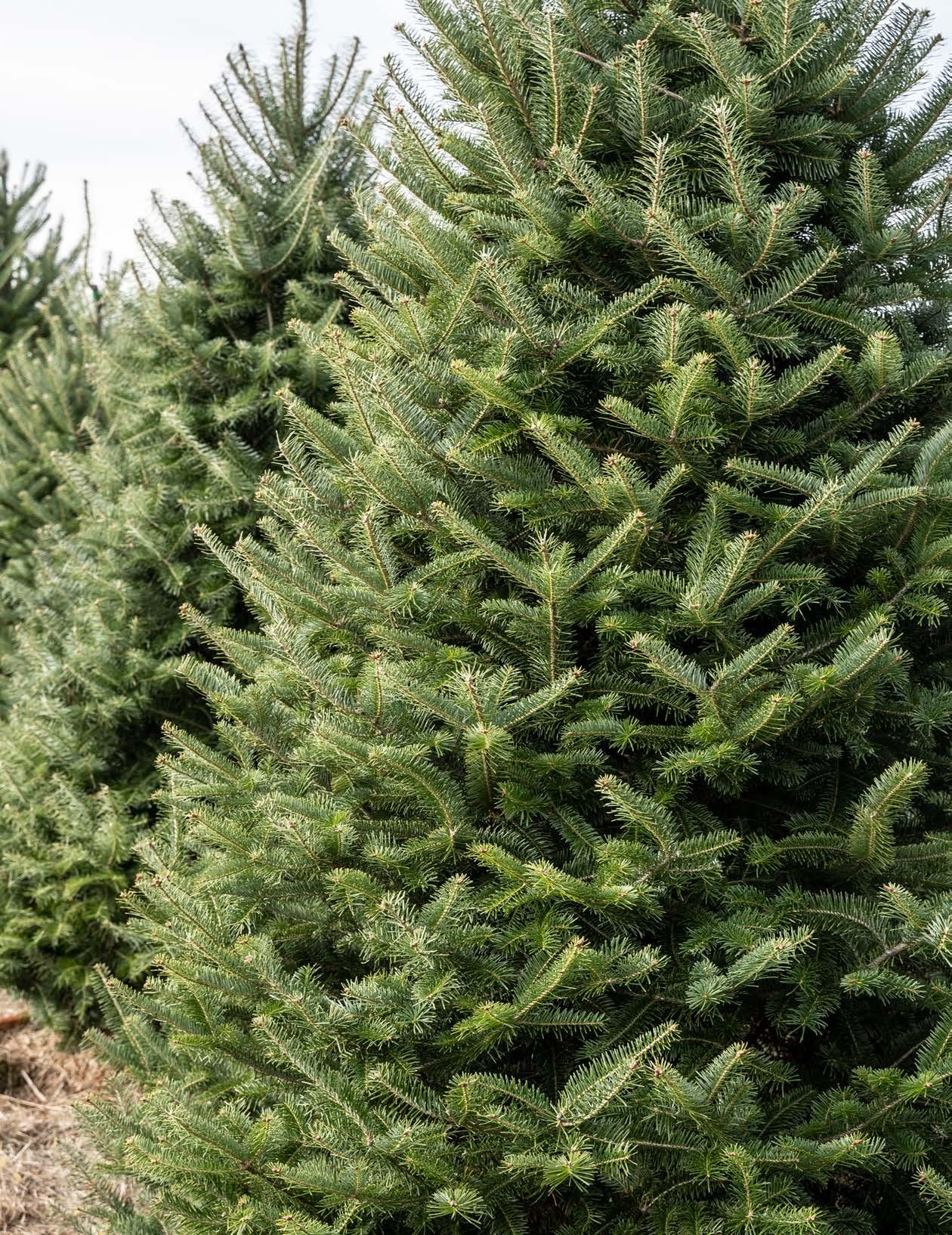
• Tomatoes
• Watermelons
• Cantaloupes
• Cucumbers
• Potatoes
• Squash
• Muscadine grapes
• Sweet Potatoes • Pecans • Peanuts
• Greens • Strawberries • Blueberries • Peaches
• Apples
• Pumpkins & more • Bedding plants
• Hanging baskets
• Perennials
• Potted Plants • Herbs • Shrubs • Succulents
• Trees
• Vegetable plants
• Cut flowers & more